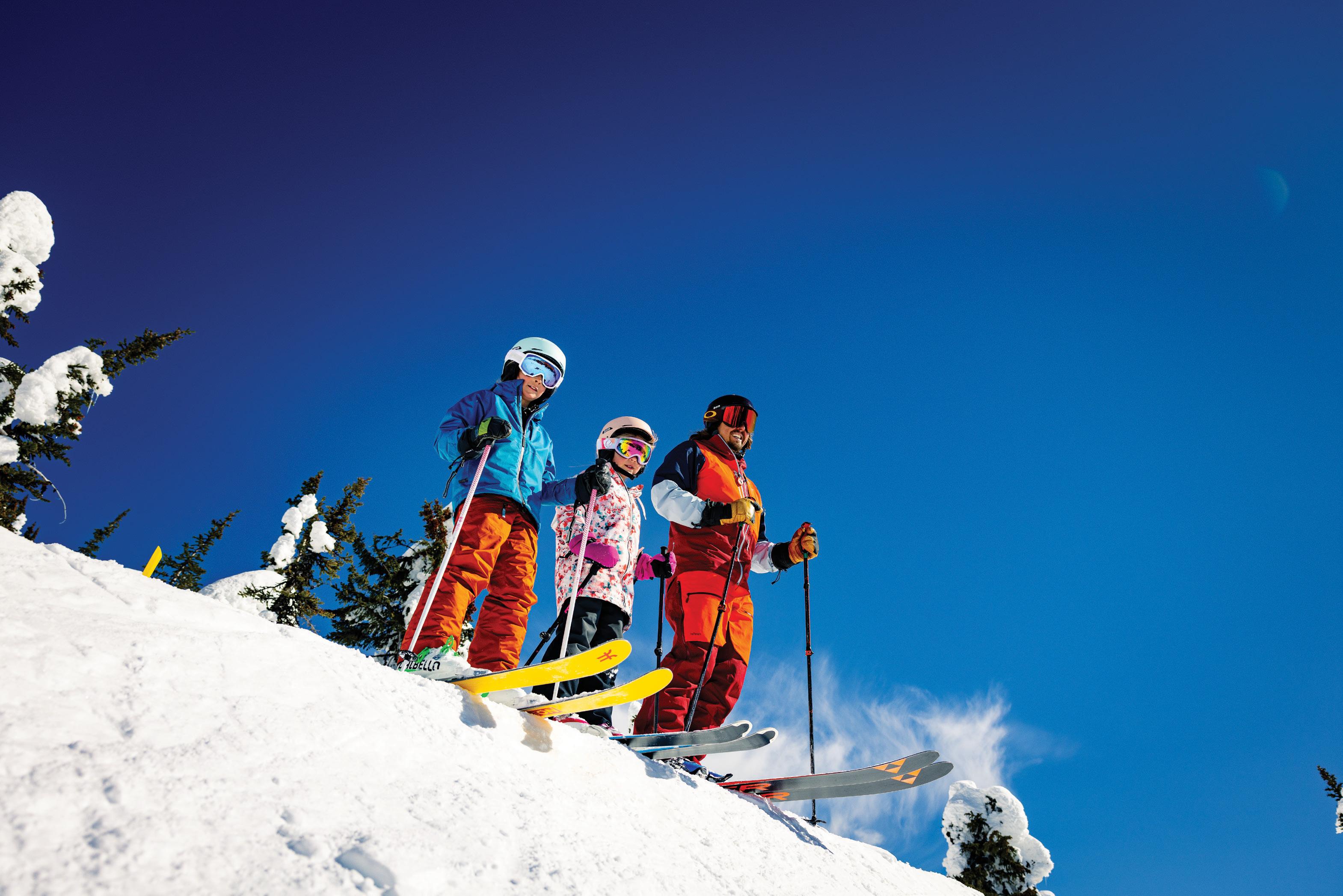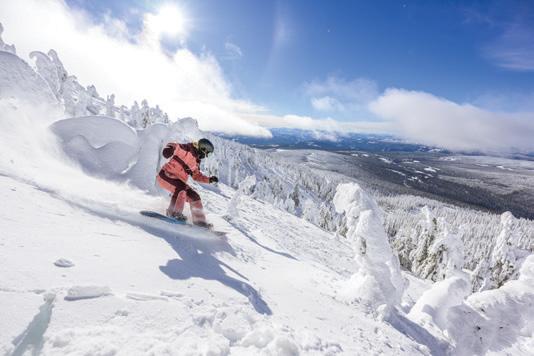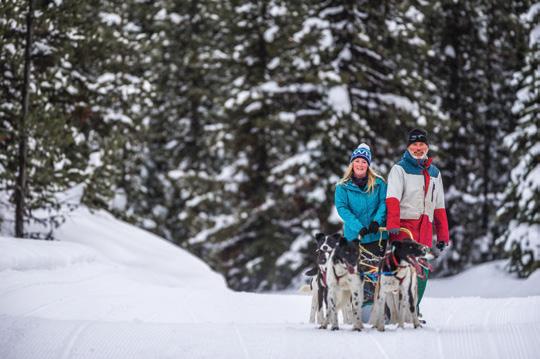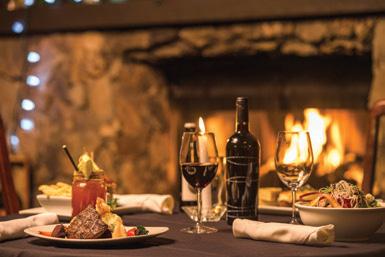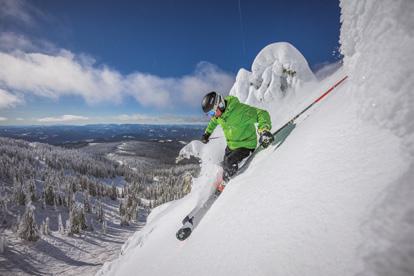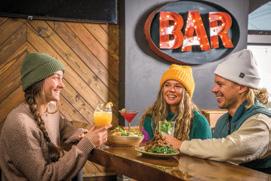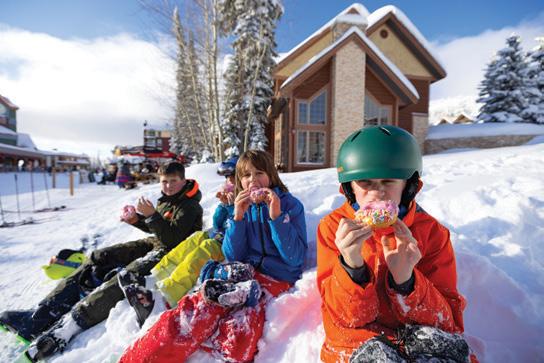CAA MAGAZINE
• Road trips, lakeside dips and outdoor tips
• St. John’s and Saint-Pierre and Miquelon
• Festivals, music and farm-to-table treats
SUMMER 2023
YOUR GUIDE TO SUMMER FUN
GET OUTSIDE AND ENJOY CANADA WITH CAA


• Road trips, lakeside dips and outdoor tips
• St. John’s and Saint-Pierre and Miquelon
• Festivals, music and farm-to-table treats
GET OUTSIDE AND ENJOY CANADA WITH CAA

There’s nothing gloomy about rainy days. That is, when you have WeatherTech FloorLiners. Laser measured for your specific vehicle, the WeatherTech FloorLiner is guaranteed to provide a perfect fit and the ultimate carpet protection, for as long as you own your vehicle. So when Mother Nature is at her worst, don’t worry because we’re at our best.


A LETTER FROM OUR CHAIR CONTRIBUTORS MEMBER LETTERS ON THE RADAR
Travel, arts, culture, local hot spots and more.
TECH TIPS
Stay connected when you’re far from home.
CAR THEFT
New technologies promise high-tech security.
THE GOOD PLACE
Arts and cultural programs are open to all children and youth in Saskatchewan, thanks to the non-profit Creative Kids.
TESTING THE WATERS Meet the volunteers protecting our lakes, rivers and streams.
THE TRUTH ABOUT EVs Setting the record straight about common electric-vehicle myths. GOOD TO GO This high-school teacher from Alberta is cultivating a love for agriculture far beyond the classroom.
NORTH ISLAND TIME
New Zealand’s diverse landscapes and natural attractions make it the perfect place to linger.
ROCK MY WORLD
How to combine a visit to Newfoundland’s capital city and a trip to France in one holiday.
SUMMER ADVENTURE GUIDE CAA Member updates, helpful resources and what’s coming next.
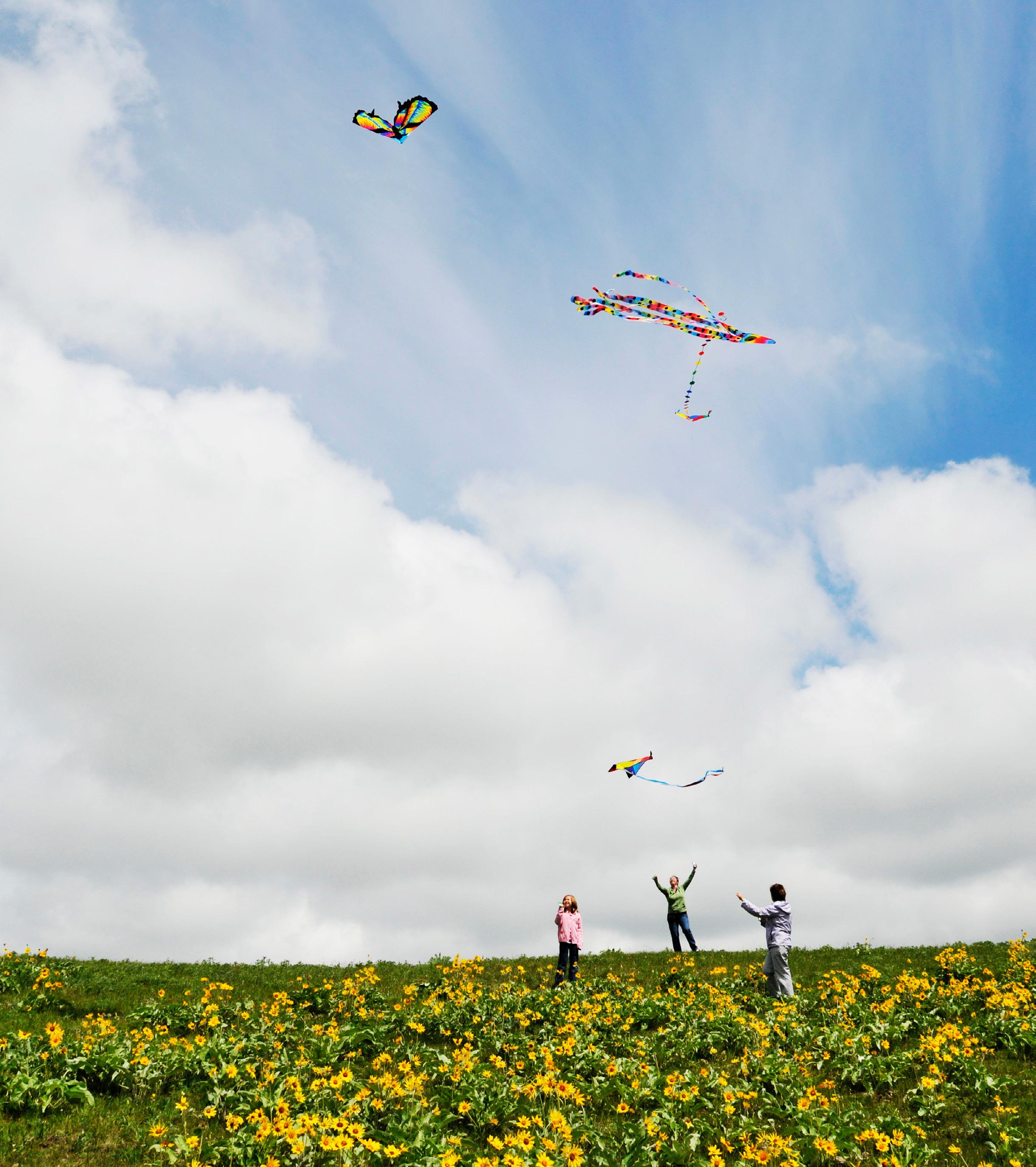
WE HAVE A RICH HISTORY IN THIS PROVINCE, supporting our valued Members who trust CAA for their everyday lifestyle needs—travel, insurance, automotive, roadside assistance and safety. Our Member-driven organization started in 1917. Now in our 106th year, we continue to work on behalf of our 185,000 Members and the public. We advocate for the safety of all road users, including motorists, pedestrians, cyclists and air travellers, by providing timely information and research.
This past March, I, along with Fred Titanich—president and CEO of CAA Saskatchewan—had the distinct pleasure of meeting with the Honourable Jeremy Cockrill, who currently serves as Minister of Highways and Minister Responsible for Saskatchewan Water Security Agency. The agenda items included CAA Travel, CAA Worst Roads Campaign and CAA’s Slow Down Move Over Day, on May 9, 2023. We enjoyed a positive discussion, which resulted in an agreement between the Ministry of Highways and CAA Saskatchewan to continue working together for the safety of our Members and all residents of Saskatchewan.

And speaking of safety, summer travel to visit family and friends is certainly top of mind. Be sure to contact our local CAA Travel Consultants to help with your air travel plans for flights and accommodations, as well as vacation advice. As Saskatchewan is a landlocked province, road travel is essential to enjoy its amazing provincial and regional parks, driving to the family cottage or taking in local events and festivals. CAA Roadside Assistance is available 24/7, 365 days a year, so now’s the time to renew or perhaps purchase your CAA Membership. Travel safely by making sure your vehicle is summer-road-ready. RV’ing? Check your vehicle’s wheels. The same goes for boat trailers and camper trailers. Eliminate distracted driving and remember to slow down or move over for first responders working on our provincial highways, including tow truck operators, construction crews, law enforcement, paramedics and firefighters.
We appreciate that CAA has been recognized nationally as Canada’s Most Trusted Brand for the past several consecutive years and we don’t take this recognition lightly. We promise to continue to offer exceptional products and professional customer service to our Members and clients. Your opinion and comments do matter. Drop us a line at notify@caask.ca with your thoughts or questions.
Take care and stay safe. CAA
Brian L. Barber Chair CAA Saskatchewan Board of Directors
CAA Saskatchewan Board of Directors
Truc Nguyen is a communications professional and a freelance style and travel writer for many publications, including Elle Canada, CBC Life, and The Globe and Mail. Previously, she was a senior editor at Flare and an associate editor at American Vogue Living. When she’s not hunting for truffles in Oregon or chasing the northern lights in the Yukon, Truc lives in Toronto with her family.
Jack Daly is a Glasgow-based illustrator, artist and graphic designer who was born on the bonnie banks of Loch Lomond, in southern Scotland. Formerly a successful brand designer, Jack has shifted careers and is now a full-time freelance illustrator. His impressive body of work spans the spectrum—from editorial to advertising and design packaging—as does his client roster, which includes The New York Times, BMW and pop singer/songwriter Adele.
Editor Dick Snyder
Executive Art Director Lionel Bebbington
CAA Saskatchewan Editor Christine Niemczyk
Copy Chief Dali Castro
Managing Editor Emily Rivas

Senior Editors Karen Eull, Jen Mallia
Editorial Assistant Alexis Ramlall
ART
Senior Designer Lauren Livingston
Junior Designer Zoë Rod
PRODUCTION
Production Manager Kim Latreille
FINALLY CONTENT
President Eric Schneider
Creative Director Abi Slone

Account Director Tobiasz Woroniecki

Vice President, Media Sales Laura Maurice laura.maurice@finallycontent.com
National Account Manager Dana Francoz dana.francoz@finallycontent.com
Account Manager Rachelle Vaughan rachelle.vaughan@finallycontent.com
CONTRIBUTORS
Jenn Smith Nelson is a multi-award-winning freelance travel writer, photographer and author based in Saskatchewan. She has been published in four countries and in four languages, contributing hundreds of articles to numerous outlets, such as enRoute, The Globe and Mail, Toronto Star, explore and Canadian Geographic. Jenn often writes about connecting with nature, wildlife, family and adventure travel.
Karen Bliss, Lola Augustine Brown, Jason van Bruggen, Matt Bubbers, Jack Daly, Sean Deasy, Daniel Ehrenworth, Jason Franson, Jeremy Freed, Lisa Gordon, Stephen Alexander Harris, Yuki Hayashi, Vawn Himmelsbach, Beth Hitchcock, Val Howes, Sam Island, Cailynn Klingbeil, Claudia Laroye, Jenn Smith Nelson, Truc Nguyen, Kate Rae, Megan Richards, Danielle Tocker, Tracey Tong, Vivan Vassos, Damien Weighill
Advertising in CAA Saskatchewan Magazine does not indicate an endorsement by CAA Saskatchewan. ®CAA, CAA Plus, CAA Rewards, Away from Home, CAA Plus RV, CAA Dollars, CAA School Safety Patrol and Approved Auto Repair Services are trademarks owned by, and their use granted by, the Canadian Automobile Association. ® AAA, CampBook, Show Your Card & Save, TourBook and TripTik are trademarks owned by, and their use granted by, the American Automobile Association. Subscription rates: Canada $14.95 per year, plus applicable taxes; outside Canada $20.95 per year, no tax. Rates quoted are for non-members only. Publications Mail Product Sales Agreement #42494512. CAA Saskatchewan Magazine is published four times per year by Finally Content Inc.; 6D-7398 Yonge St, Unit 131, Thornhill ON, L4J 8J2; on behalf of CAA Saskatchewan. © 2022. All rights reserved. No part of this periodical may be reproduced in any form without the consent of CAA Saskatchewan.





Having a CAA membership is like having house insurance—you never think of it until you need it. I have been fortunate to only have had that type of situation happen to me once. Outside of Chicago, I had a flat tire on the freeway and I called for Roadside Assistance. A short while later, a tow truck the size of a house shows up, parks behind me on the shoulder and changes my tire for me. I asked why we needed such a big truck? His answer: safety. With the amount of traffic, that huge tow truck protected him, my wife and me while he was doing the work. The service that I received paid for my membership right then and there.
 —Steve and Marilyn Harris
—Steve and Marilyn Harris

My truck’s battery quit on King Street and I didn’t know about CAA’s Mobile Battery Service until that day. The representative who helped me went above and beyond. On a scale of 1 to 10, this service is definitely a 20! Thank you so much.
—Sharlette
Lisa from the CAA Moose Jaw store provided me with the most amazing help I could’ve asked for. She was so reassuring. After hours of fighting with an airline on my own and getting nowhere, Lisa was able to get me a full cash refund and re-book my flight. Thank you so much, Lisa. I will be coming back for future travel plans.
—RainaLast November, I came home to find that I couldn’t open my front door. It certainly was no fun to be locked out in the kind of weather we had that day. Luckily, I have CAA Premier coverage, which includes locksmith services. As the weather forecast was for a snowstorm, my CAA call counsellor had to call many locksmiths before he finally found one to come all the way from Regina. Despite the bad weather, the locksmith arrived and was able to open my front door. What a relief! I am grateful to CAA for the help I received that day.
—ChristelIn our spring issue, we ran an article on roundabouts. Definitions of roundabouts, rotaries and traffic circles vary widely, so it’s difficult to corroborate hard data— dates on their introduction in Canada and even how many were installed across the country. We apologize for this oversight and will do better next time.
On a scale of 1 to 10, this service is definitely a 20!
























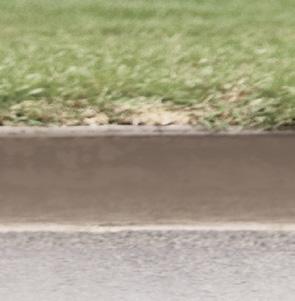








WHEN
dining alfresco this summer, think outside the patio and go further afield, literally, with unique experiences that are as local as can be. These farms offer seasonal fare just a fork’s throw from where it is grown and nurtured.

At Mabel Hill Farm Kitchen & Marketplace, in Nipawin, Sask., diners can sit on a covered veranda overlooking the vast gardens and orchards, or gather inside the modern-rustic farmhouse. Before heading home, check out the marketplace for takehome treats like fresh herbs and produce, meat pies and artisanal preserves.
One of the most coveted reservations in the Ontario countryside, Eigensinn Farm is the passion project of pioneering farm-to-table chef Michael Stadtländer. For the epic eight-course dinner, almost every ingre -

dient—from maple syrup and honey to fowl and livestock—is sourced from the 100-acre property.
At Prairie Berry Farm, a Métis-owned business in Glenlea, Man., farmers
Jennifer and Matthieu Turenne team up with Indigenous and local chefs for two weeks each summer to create a seasonal berry-themed menu. These juicy, multi-course dinners are served in gazebos in their strawberry patch.
The FireWorks Feast at chef Michael Smith’s Inn at Bay Fortune, near Souris, is PEI’s hottest ticket. After touring the farm, guests indulge in a spectacular meal of delicacies foraged, organically grown, or procured locally. And that includes unlimited fresh oysters to start.
At Bika Farm, just outside of Montreal, the cuisine has
farms offer
a Turkish twist—chef Fisun Ercan grew up on Türkiye’s (formerly known as Turkey) Aegean coast. The solarium seats just 28, and it’s a perfect perch to watch Ercan move between kitchen and garden, transforming sustainably produced ingredients into Mediterranean classics.
Ready to play sous-chef?
Learn to cook local meat over an open flame with an experienced ‘firemaster’ at The Old Red Barn, about 35 kilometres south of Edmonton. A three-hour demonstration leads to a multi-course meal. Even the dessert is fire-roasted.
Don’t forget travel insurance—it’s as important for domestic trips as it is for international journeys. Visit caask.ca/insurance/travel-insurance to learn more.
These
seasonal fare just a fork’s throw from where it is grown and nurtured.Chef Michael Brownlee moved home to create Mabel Hill Farm Kitchen & Marketplace.
DOROTHY LONG WAS RUNNING A BOOTH at an agricultural fair in Ontario when a little girl came up to her. “Is that a cow?” the girl asked, gesturing to an animal nearby.
“That really hit home,” says Long, who grew up in Lloydminster, Sask., on a farm operated by her parents and grandparents. “I knew then that there was a lot of work to do to help Canadians connect with agriculture and I spent hours riding horses with my cousins and neighbours. It was a wonderful way to grow up.”
It’s a lifestyle promoted by Long, who is the director of communications at Farm & Food Care Saskatchewan. “Only 3 percent of Canadians are involved in food production. That means 97 percent don’t have a direct knowledge of how their food is grown, raised or produced.”

And that leaves a lot of room for misinformation. Long’s solution? Host food writers, chefs, dietitians and health influencers on family farms, so they can learn first-hand what rural life is all about. Real people talking to real people. All questions are welcome—even the one about cows.
–Vivian VassosNominate a localer. We’d love to hear about people doing great things in your community. Send ideas to caa.magazine@caask.ca and they could be featured in an upcoming issue.
Delectable freeze-dried confectionery is a specialty at Living Sky, which is located in the town of Shaunavon. Explore its wide range of offerings, from classic favourites (candy corn) to innovative takes (fruit crunchies, marshmallow twists). Available at markets and shops across the province.

For a meal that’s as well curated as the 8,000 permanent artworks surrounding it, visit Saskatoon’s Remai Modern gallery and dine at the new location of Hearth.

Restaurant owners Beth Rogers and Thayne Robstad say it’s “a celebration of Saskatchewan.” On the menu? Prairieforward fare, like bison tartare, trout cooked in paper with grains, and sorbet made from local haskap berries.
–Beth Hitchcock
Before letting dogs run free, take them through these training tips. A good run provides exercise and mental stimulation for your dog, but before removing that leash, you want to be sure Buddy will come back when called.
Proper recall training is essential to prevent dogs from wandering onto a road or getting lost. Melissa Millett, head dog-training instructor at In Dogs We Trust in London, Ont., shares recall training tips for pups (or any dog who needs a summer refresher).
The first step, she says, is teaching Buddy to focus. Reward him each time he makes eye contact without prompting while on a leashed walk.
Next, practise restrained recall in a fenced area. Have someone hold the dog while you move a few metres away. Call him by name and say, “Come,” as your helper releases the lead. Always reward him for coming—even if it takes a while.
Still don’t trust your pup’s recall skills? Don’t force it. Of Millett’s nine professionally trained dogs, she only allows six off leash. “One is a terrier with a high prey drive, another is only two pounds and could be a snack for a bird of prey, another is a deaf car-chaser,” she says. “Many dogs are happy with hikes on long leashes and enjoy running in fenced yards.” –Tracey
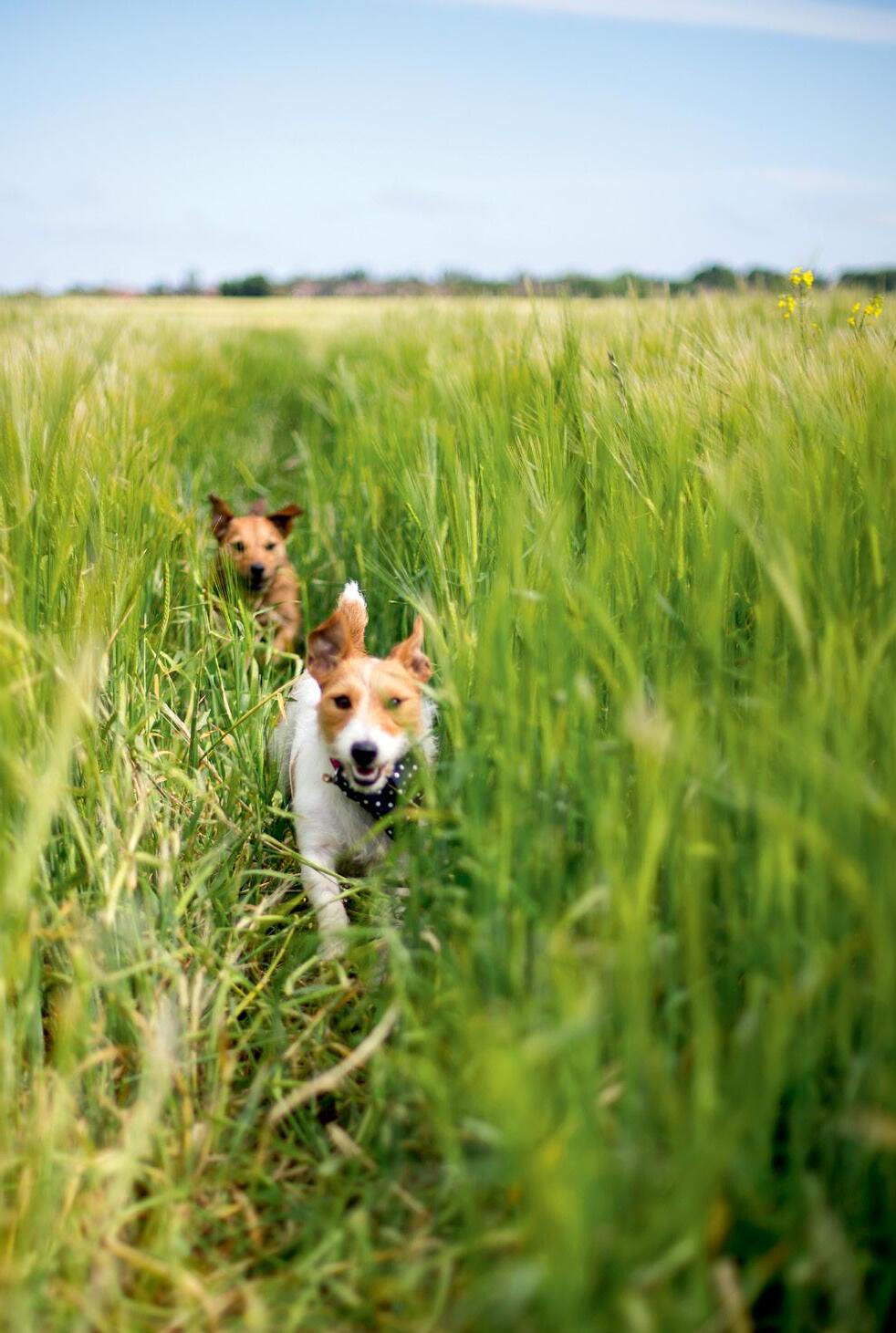 Tong
Tong
Protect your pet. CAA Members receive a preferred 12% discounted rate on Pets Plus Us Insurance. Visit caask.ca/insurance/pet-insurance to learn more.
Owners Beth Rogers and Thayne Robstad say Hearth is ‘a celebration of Saskatchewan.’
Six spectacular bike rides for a summer day.
From towering mountains to dramatic coastlines, Canada offers so much to see on two wheels. Here are six scenic rides to do in a day (with plenty of time to stop for pictures).
Confederation Trail, PEI
Spanning 273 kilometres, this old railway line, now a popular hiking/ biking trail, runs through the centre of the island. The easternmost section, from Morell to Elmira, is a moderate day ride with the best views of the coastline, past fishing villages and scenic St. Peters Bay.
54 km one way
Pelee Island Waterfront Trail, Ontario
A 90-minute ferry trip from Leamington or Kingsville drops riders off at the trailhead by the Pelee Island dock. Family-friendly trails fringe the largest island on Lake Erie, past beaches, nature reserves and Ontario’s oldest wine region (now Pelee Island Vineyards).

30 km loop
Niagara River Recreation Trail, Ontario

This paved path beside the Niagara River zips right past the roiling waters of the falls and into historic downtown Niagara Falls with its many cafés and attractions, including one of North America’s largest Victorian rose gardens—a fragrant spot for a breather.
56 km one way
Riding Mountain National Park, Manitoba
A ride through grasslands, forests and many lakes leads to the resort townsite of Wasagaming. This national park boasts nearly 370 kilometres of trails with bike routes that vary from easy to rugged climbs. The Strathclair Trail is a moderate option with a gentle downhill grade.

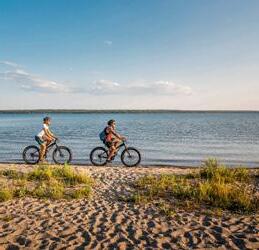
23 km one way
Meewasin Trail, Saskatchewan
This lengthy 105-kilometre trail lives up to its name—meewasin is nêhiyawêwin (Cree) for “It is beautiful.” Start at the Remai Modern and wind along the banks of the South Saskatchewan River—past shopping and cafés—to Wanuskewin Heritage Park.

16.5 km one way
Bow Valley Parkway, Alberta
This road route features stunning mountain views through Banff National Park, ending at the turquoise waters of Lake Louise. A pilot program, running in June and September, will limit vehicle use on the parkway, making this unforgettable trip even better for road cyclists.

48 km one way
– Cailynn Klingbeil
Worried about a flat tire or broken chain?
Your CAA membership includes roadside assistance for you and your bicycle. Visit caask.ca/bikeassist to learn more.

The famed singer and actor from One Arrow First Nation, Sask., is a big supporter of homegrown music. Tom Jackson’s playlist features quite a few classics. “While [I’m] on the road, usually between Calgary and Winnipeg, my choices are pretty eclectic. Music keeps me awake and energized, usually accompanied with a Red Bull,” he says.
–Karen Bliss
The Silver Tongued Devil and I
Kris Kristofferson
Rock and Roll Doctor
Little Feat
Heavenly Bodies
The Nylons
Second Cup of Coffee
Gordon Lightfood
Streets of Philadelphia
Molly Johnson
It Doesn’t Matter Anymore
Eva Cassidy
Stand Tall
Burton Cummings
Just Came Back
Colin James
Hallelujah
k.d. lang
Sounds of Silence
Simon & Garfunkel
Gear up to ensure you’re seen, heard and protected when cycling.
WHETHER ON TWO WHEELS, four or more, it’s everyone’s responsibility to stay focused and follow road laws to protect cyclists. More often than not, cyclists and drivers end up on the same roads where tension—and collisions—may occur.

Here’s how cyclists can stay well equipped for a safe ride:
Helmets To ensure the right fit, follow the 2-V-1 rule. The helmet rim should sit two finger widths above the eyebrows. Ensure the straps form a V under the ears. One finger should fit between the chin and chin strap.
Bells Bicycles need a working bell or horn to alert other cyclists when you’re approaching or attempting to pass. But don’t assume a bell is loud enough to alert cars of your presence.
Lights All bikes must be illuminated for rides at night and on rainy or foggy days. Attach a white light to the handlebars or the front of the frame and add a red rear light and reflector.
Clothing Wear proper running or cycling shoes, along with fitted pants that won’t get caught in the chain. Consider adding reflective tape to clothes, helmet and bike.
Get more road safety tips Learn about CAA’s #ShareTheRoad campaign on page 39.
Jump in the car and fire up the GPS. Your destination: one of the many lively music, art, food and cultural festivals being staged across the country this summer. There’s fun for everyone, whether you’re looking for something local or you’re ready for a road trip.
What’s that mouth-watering aroma wafting across Toronto’s Woodbine Park? It’s the Toronto Food Truck Festival and those mobile kitchens are serving up sizzling snacks (think dumplings, tacos and fritters) from August 4 to 7.
Here’s something for crustacean lovers to dig their claws into. The PEI International Shellfish Festival is celebrating its 25th anniversary, September 14 to 17, at Charlottetown’s Event Grounds. Load up on lobster rolls or watch the shucking championship to learn best-in-show techniques.
Regina’s Victoria Park comes alive with free daytime concerts on four stages—plus a designated children’s area, vendors’ market and beer garden—during Regina Folk Festival, August 11 to 13.
Creativity prevails at the Manitoba Electronic Music Exhibition, June 8 to 10, with innovative workshops and performances by cutting-edge local musicians and artists.
When it comes to summer fun, there’s more to Alberta than the legendary Calgary Stampede. The Grande Prairie Night Market Festival (June 23 to 25, July 14 to 16, August 11 to 13 this year) is an all-ages celebration of community and diversity through food and crafts, plus live performances.
And finally, stroll through picturesque Queen’s Royal Park in Niagara-on-the-Lake and take in the juried show of more than 80 artists and artisans at Artistry by the Lake on the first three days of July.
–Beth HitchcockStay safe. Visit caask.ca/bikesafety to learn more.
It’s everyone’s responsibility to stay focused and follow road laws to protect cyclists.
DOES THE THOUGHT of travelling and not being tech-connected (or getting hacked!) terrify you? Here’s how to protect yourself online when you’re on a trip, whether for work or for a vacation.

The bane of many a traveller’s existence, high roaming charges can take the shine off an otherwise productive work trip or a relaxing vacation. Canada’s wireless rates are among the highest in the world, according to a survey conducted earlier this year by Rewheel, a telecom research company based in Helsinki. Make it easy on yourself by investing in a dual-SIM phone, such as the Samsung Galaxy S22+ or the Apple iPhone 13 Pro Max. Then pick up a SIM card at your destination, which would allow you to use your phone via a local number and service provider, as well as check your home number in Canada for messages by toggling between the two SIMs. You can even forgo roaming charges altogether by relying on apps like Signal and WhatsApp to make calls and send text messages.
More than 70,000 cyber-crime incidents were reported to police in 2021, according to Statistics Canada. But there are ways to stay cyber-safe. When you use your devices at an Internet cafe or via a shared Wi-Fi network, always assume that your data is not se-
cure. Consider a virtual private network (VPN) service to encrypt your information and identity when you go online. You can also set a location that is different from where you are. This avoids restrictions based on geography, involving sites that let you log in only from your home province. Look into subscription services such as NordVPN, Surfshark and ExpressVPN.
Make sure your devices have enough battery power when you arrive at your destination, so you can access your reservations, maps and travel documents. Take advantage of power ports on the plane or at the airport. And for convenience and peace of mind, purchase a portable power bank.
Look for compact, lockable bags with slash-proof panels and RFID-blocking material to safely stash your devices as well as travel documents and currency.
Keep these tips in mind, whether you’re travelling for work, you’ve opted for a digitally nomadic lifestyle or, perhaps, you just want to stay connected while away for the weekend. Speak to a CAA Travel Consultant when planning your next trip. Or stop by for a visit—many of our locations carry essential travel gadgets and gear. CAA
CAA has your tech accessories! Visit your local CAA Store for a selection of gadgets to help keep all your devices working while you’re in transit—and keep them protected with CAA Travel Insurance. See caask.ca/travel for details.
 By Jeremy Freed | Illustration by Damien Weighill
By Jeremy Freed | Illustration by Damien Weighill
AS ANYONE who has recently driven a new vehicle knows, our cars and trucks now come loaded with a raft of high-tech features to make driving easier and safer. Despite these advances, however, even the smartest of modern vehicles is still a target for car thieves, and theft rates are on the rise, and significantly so in urban areas, like Toronto and Montreal.
As the internal systems of cars become increasingly sophisticated, so too have the methods of thieves to evade them. Common theft techniques now include easily available electronic devices to “clone” nearby key fobs, allowing thieves to enter a vehicle and drive off with it in a matter of minutes. Cars are then either sold for parts or loaded onto shipping containers for export overseas, making them next to impossible to recover. (Tip: Keep your keys in an RFID (radio frequency identification) bag, which blocks RF signals so thieves can’t intercept them.)
While no vehicle is theft-proof, some automakers offer enhanced systems for added security. Honda’s stolen-vehicle
locator—HondaLink™, offered by subscription on newer models—uses GPS technology to assist authorities in finding stolen cars. GM’s OnStar system can remotely slow down a stolen vehicle to hamper a thief’s getaway. Other add-ons, like BMW’s Drive Recorder and Tesla’s Sentry Mode, turn a vehicle’s cameras into a surveillance system that can capture thieves in the act.
Automakers are also responding to high-tech thievery in more direct ways, notes Sam Abuelsamid, a mobility analyst at consulting firm Guidehouse Insights. “What we’re starting to see now is something known as ultra-wideband [UWB] technology,” he says. By using a complex and precise system of communication between the fob and the car, UWB is more difficult to fool than previous generations of remote fobs, he explains. “It identifies you and authenticates where you are before it’ll unlock the door and start the car, so it’s a much more secure system.”
Other security features Canadians can expect to see are biometric scanners like the ones found on smartphones. “I think
biometrics is probably going to be the next big thing that we see roll out more broadly,” Abuelsamid predicts, noting that the technology is already available in the Genesis GV70 SUV, which uses a fingerprint reader to identify the authorized drivers.
Despite these advances, our cars’ reliance on wireless networks invites opportunities for thieves to hack them. “The more points of connectivity you have, the more potential there is for bad actors to get in and do anything, from stealing your data to disabling your car with a ransomware attack,” Abuelsamid says. The auto industry is aware of these weaknesses, he says, and manufacturers are taking action.
For now, authorities suggest investing in visual deterrents, such as a steering wheel lock—though a determined thief can deactivate these quite easily. Making the vehicle less attractive by parking under a light or in a secured garage can also help.
In this era of increasingly high-tech cars, it turns out that low-tech measures remain as effective as ever. CAA
QUESTIONS ABOUT YOUR CAR INSURANCE? Speak to a CAA Insurance Agent to review your policy and ensure you have the best coverage at the best rates. Visit caask.ca/insurance/auto for details.
With its diversity of dramatic landscapes and natural attractions, New Zealand’s North Island is a place made for lingering.
By Truc NguyenSITTING ON THE WHITE SAND at Onetangi Beach—amid dazzling turquoise waters, colourful wildflowers and boldly painted food trucks serving up smash burgers and fresh ceviche—it takes me mere minutes to fall hard for Waiheke Island. But it takes much longer to experience all that northern New Zealand has to offer.
With 600-plus islands and more than 15,000 kilometres of coastline, there’s so much to explore in New Zealand that it’s difficult to check off the highlights of even just the North Island within a visit of one or two weeks. Why cram those top sights into an intense multi-day road trip if you can swing a leisurely extended stay?
This page: Wai-O-Tapu Thermal Wonderland, with it's vividly coloured pools, is just a short drive from Rotorua; opposite page: Auckland, New Zealand's largest city, offers culture, shopping and fine dining—with beaches, rainforests and wineries nearby.
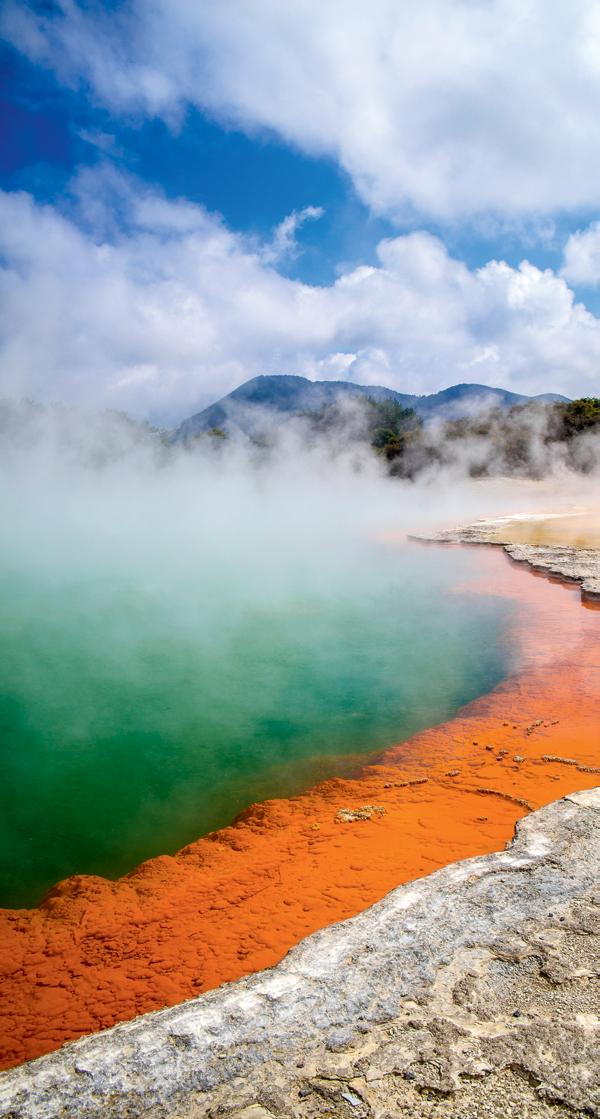
Some destinations are simply too special to rush through. And, trending alongside flexible time-off plans and remotework scenarios are extended, or long-stay, vacations. Embracing a slower pace of travel means not having to choose between restful beach days and exciting cultural experiences, both of which northern New Zealand offers plenty.
Long stays also make it more worthwhile to travel great distances. After all, it’s not easy to make it to Aotearoa, or “land of the long white cloud,” as New Zealand is known in Māori. It takes more than 13 hours to fly directly to Auckland from Vancouver, and you might need a day or two to get over jet lag.
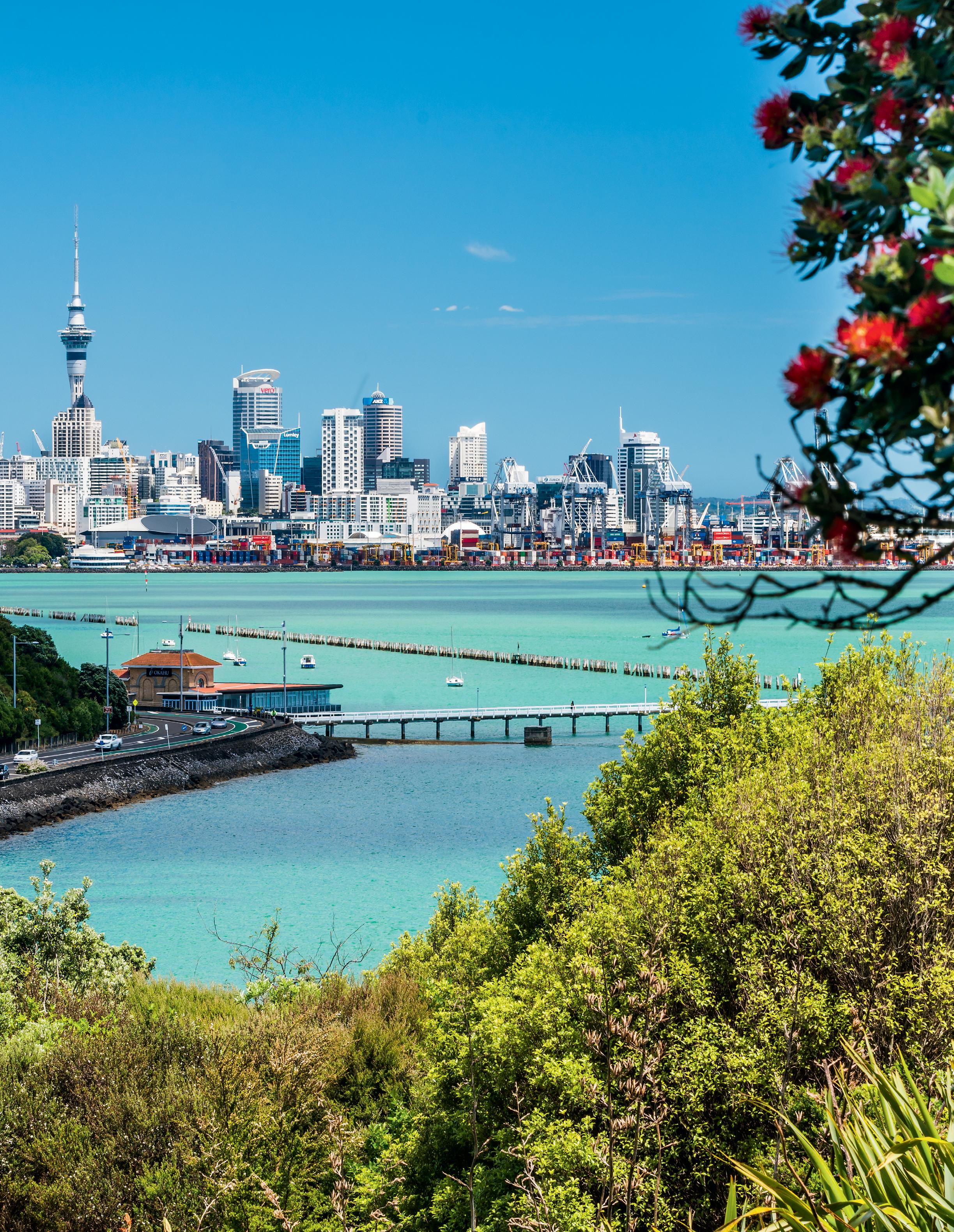
And although the North Island is relatively compact (it’s a little larger than the island of Newfoundland), its winding hilly roads can add to your driving time, and unpredictable weather can sidetrack even the best-laid plans (tip: pack expecting to experience three seasons in a day).
Start your journey in Auckland, the largest city in New Zealand and a hub for travellers. Rent a car and head south to the city of Rotorua and its numerous tourist attractions, then to the Northland to explore stunning subtropical beaches and fascinating historical sites.
The city’s corporate core has many hotels and apartments for rent, but you can also opt for a charming bungalow or spacious villa in the trendy suburbs of Ponsonby or Grey Lynn as your home base. Your urban forays must include the Auckland Art Gallery, shopping at the designer boutiques of Britomart and a sunset hike up Mount Eden. Spend evenings mingling with the locals in the neighbourhood bars and restaurants near your rental.

Pick a sunny day to take the 40-minute ferry ride from downtown Auckland to picturesque Waiheke Island for glimpses of olive groves and vineyards, pristine white sand beaches and brilliant blue waters around every bend. Reserve a Saturday morning for the famous Matakana Village Farmers’ Market, which is worth the hour-long drive north of the city, especially if you make time to visit Matakana Oysters and Sawmill Brewery.
One could easily spend a week or more sightseeing in and around Rotorua, which is almost three hours south of Auckland. Known for its geothermal activity and (sometimes strong) sulphur smell, this city also boasts world-class mountain biking trails. Get hands-on at a geothermal reserve and mud spa, go on a treetop walk in a redwood forest and watch a Māori cultural performance. From Rotorua, it’s an easy day trip to iconic tourist attractions, such as the Hobbiton movie set and the eerily lit Waitomo Glowworm Caves.


The Bay of Islands is a subtropical beach paradise in what's called the "winterless north" of New Zealand.
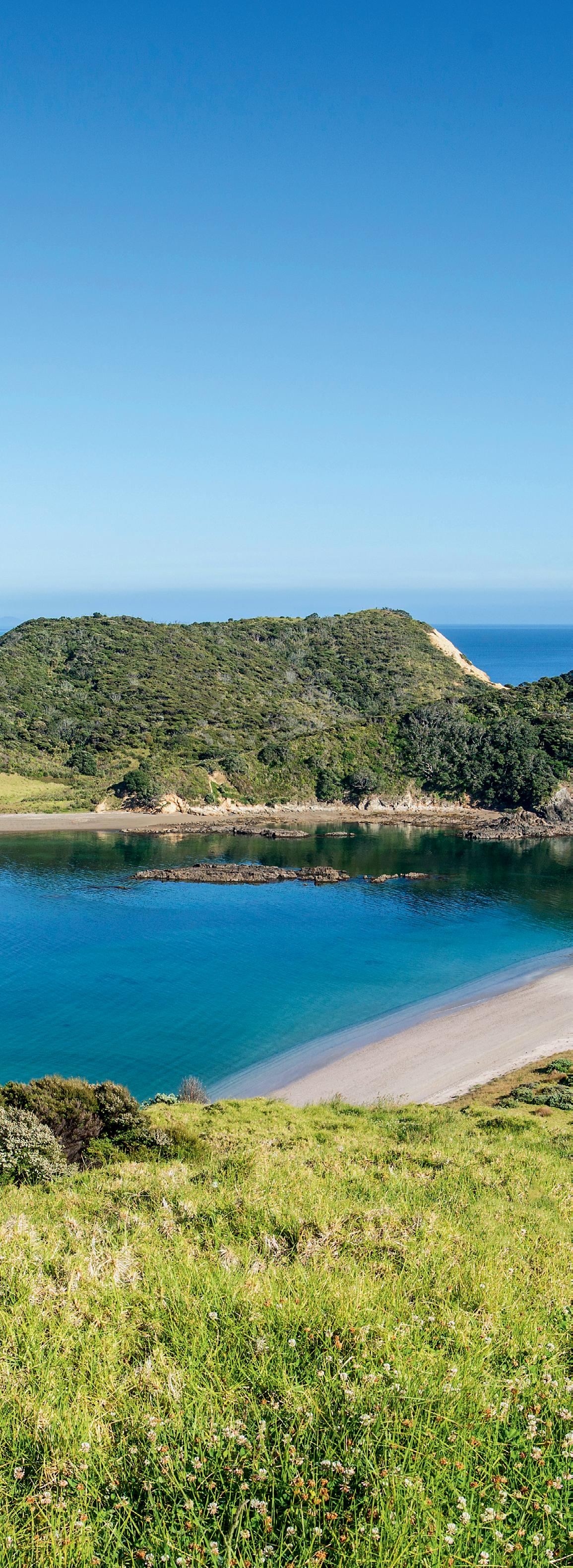
In the subtropical Northland region, about three hours north of Auckland, are beautiful orchards of persimmon, kiwifruit and mandarin trees—and more picture-perfect glorious beaches. Take a scenic hike through a forest of majestic kauri trees, past stunning waterfalls. Stop by the Waitangi Treaty Grounds, where the country’s Declaration of Independence was signed in 1835. Admission tickets are good for two consecutive days, so you can take in, at your own pace, the site’s heritage buildings and two museums to find out more about Māori history and culture.
Stay a week or longer in each of these regions to explore the bounty of beaches and charming small towns. Having enough time to visit a destination’s bucket list of attractions and stumbling upon under-the-radar local gems—that’s the best part of the long-stay vacation. CAA
• Canadian passport holders need an approved electronic visa waiver, called a New Zealand Electronic Travel Authority (NZeTA), to board their flight. Note that the application process can take more than 72 hours.
• Travellers planning to stay longer than three months must apply for a visitor visa, which takes at least 44 days to process.
• In New Zealand, travel insurance is required for some visa categories and is recommended for visitors using the NZeTA visa waiver.
• We recommend purchasing travel insurance as soon as you book your tickets with CAA. No matter where you travel, CAA Travel Insurance plans can protect you against the finanacial impacts of illness, emergencies and the unexpected. Protect yourself and your loved ones by purchasing CAA Travel Insurance for your next vacation. Take the stress out of travelling by ensuring you're covered by Canada's most trusted brand.
Choose the right coverage for your trip. Visit caask.ca/insurance/travel to get a quote.
Five favourite long-stay destinations

PORTUGAL One of Europe’s more affordable attractive destinations— sunny weather, wonderful beaches and lovely towns tiled with the worldrenowned azulejos—Portugal is popular with travellers who want to stretch their trip time—and their budget.
OAXACA CITY, MEXICO A vibrant hub of Mexican architecture, food and Indigenous arts and culture, this high desert city is flanked by mountains, with scenic drives to nearby mineral pools, waterfalls and the Zapotec pyramids of Monte Albán.
NEW ORLEANS, LOUISIANA Stroll through historic neighbourhoods in the birthplace of jazz, including Tremé, the stately Garden District and the French Quarter where every night's a festival of music and spicy Creole food.
MALTA With its ancient history, stunning coastline and year-round balmy temperatures, this archipelago is a magnet for divers and boaters, as well as travellers interested in exploring megalithic temples.
VICTORIA, B.C. Spend a few weeks in Canada’s Garden City. Start downtown with afternoon tea at the Fairmont Empress, then explore the many surrounding ecological reserves and beautiful shoreline.
Take a trip from Newfoundland’s capital to a rocky remnant of France.
 By Valerie Howes
By Valerie Howes
ST JOHN’S is a delightful mix of contradictions and complements—large enough to offer plenty of diverse, vibrant food and cultural scenes, yet small enough to explore by foot in a couple of hours. Between the colour-pop houses of Jellybean Row and the possibility of spotting icebergs, seals and spouting whales near coastal trails, this city had me hooked right from my first visit.
The streets of St. John’s are built at angles fit for ski slopes, and the weather gods cycle through every season most days, but nothing stops the locals from getting out and having fun. Live music festivals, wharf-fresh seafood and friendly banter at every turn keep visitors coming back year after year. For this trip, I’m eager for new experiences at rural spots just outside of the city and an excursion to Saint-Pierre and Miquelon—two pebbles on a rocky archipelago off the northeast coast of Newfoundland.

One of the best ways to get to know a place is through its food, and so I start off by venturing down to dine bar-side at Terre, a restaurant that’s located conveniently (for me), in the lobby of the Alt Hotel, where I am staying. Chef Matthew Swift, whose pedigree includes stints at Montreal’s Joe Beef and Le Vin Papillon, helms the kitchen and is committed to the wild, farmed and fished resources of the region. The herbs, garnishes and greens are as local as it gets— Swift grows them on the hotel deck in his greenhouse and garden.
To delve deeper into Newfoundland’s foodways, I take a 45-minute drive to Lori McCarthy’s woodland home, in Mobile, on the Avalon Peninsula.
McCarthy is a forager, outdoorswoman, award-winning author and host of the culinary-adventure TV show The East Coast Forager. Her Food Culture Place residencies get people rolling up their sleeves to try everything from pickling to butchery to campfire-making—with lots of stories and sampling along the way.
Shortly after my arrival, McCarthy hands me an antique teacup (her grandmother’s) to fill with an infusion of my
own choosing. Her red setter, Tessa, looks on as McCarthy and I chat while preparing a lunch spread of stove-top beans, golden-topped cod cakes and warm baked goods with tart partridgeberry jam.
Another of the interesting communities near St. John’s is Petty Harbour—only 15 minutes away and the birthplace of award-winning musician Alan Doyle. These days, it’s home to Janet Harron, a craftvinegar maker who gives heritage tours.
Harron strides through Petty Harbour in combat pants, her long silver hair flying from beneath a bucket hat, as she shares insider stories of community life. We take in the bridge that once divided Catholic and Protestant residents and the Fishing for Success building, where wooden boat and handline fishing traditions are kept alive. Our tour ends inside the Petty Harbour Fisherman’s Co-Operative Society building, where Janet makes her stout-fed vinegar. I sample the sharp and caramelly condiment, while looking at black and white photos of local scenes, including cheeky kids cutting cod tongues at the fish plant for pocket money.
That evening, I have reservations at Portage, a new St. John’s restaurant opened by alumni from Raymonds, the recently shuttered fine-dining spot that put Newfoundland cuisine on the world map.

The Portage menu draws on the Asian culinary heritage of chef Celeste Mah, as well as the local sensibilities of Newfoundland-born-and-raised Ross Larkin, season 6 winner of Top Chef Canada. Here, the kelly green dining room is homey, the servers chatty, and the dishes made for sharing.
On my last day in the city, I go shopping. At St. John’s Farmers’ Market, I browse stamped butter knives, cardamom-infused sugar cubes and colourful hand-stitched journals.
Later, I head downtown to Rosemill Antiques & Collectibles, on the recommendation of friends. “We sell everything here, from a baby’s fart to a clap of thunder,” says owner Rick Clarke.
Clearly, this place is full of treasures—just like the city itself.

STAY
Alt Hotel St. John’s 125 Water St. germainhotels.com/en/alt-hotel/st-johns
SHOP
St John’s Farmers’ Market 245 Freshwater Rd. sjfm.ca
EAT
Portage 128 Water St. portagenl.ca

See it with WestWorld Tours. Embark on an escorted tour this summer to see the beauty of Newfoundland & Labrador. Visit westworldtours.com or call your CAA Travel Consultant at 1-800-564-6222 to book.

Saint-Pierre’s harbour (left); dining options (opposite page, from top) include Les Feu de Braise with its chic ambience, and Roc Café, which serves up delicate origami-style buckwheat crêpes.
Three days on the French islands of Saint-Pierre and Miquelon.

AFTER A 45-MINUTE FLIGHT from St. John’s (Canadians don’t need a passport, just valid photo ID), I arrive at my hotel in Saint-Pierre. Les Terrasses du Port SPM looks out to a bustling harbour—only this time, with French flags and names like Marcel and Marie painted on the boats. Saint-Pierre is the smaller of the two main islands in this self-governed, French-owned archipelago. It’s also the most urban—in the loosest sense of the word—with a population of about 5,300. Summer visitors to these islands include dolphins, orcas and puffins—as well as francophiles eager to spend their euros on fresh-baked croissants and stinky cheeses.
Saint-Pierre and Miquelon had its heyday during Prohibition, when islanders supplied booze from their “wet” French territory to be smuggled to the dry U.S.A. Today tourism and fishing are the main economic drivers. Keen to understand the history of this distinctive place, I start my visit at Le Musée de l’Arche.
My legs tremble as I stand by a guillotine as tall as an NBA star and listen to my guide recount the sole public execution in these parts. It was the first and last guillotine execution in North America.
I examine stone microblades, chiselled for skinning animals, as I read about the Indigenous peoples who came to hunt, fish
and gather here millennia ago. And I take in treasures recovered from some of the 600plus shipwrecks on record from the past 200 years—the North Atlantic doesn’t play around on stormy days.
Later that day, crossing lichen-covered rocks over tree-less terrain, I’m able to put the history and culture of this place into its geographical context, thanks to my guide, Gilles Gloaguen, of Escapade Insulaire.
As I take in undulating landscapes carved by melting glaciers, Gloaquen points out a soaring trio of bald eagles. We pick wild cranberries as we hike and chat about the fishing grounds, the semi-wild horses that roam in herds, the challenges
of farming on a rock, and the presence of white-tailed deer and snowshoe hares that were introduced for hunting.
To get a taste of local heritage crafts, I spend my final morning at Chez Rika Simon, a studio-boutique redolent of leather and sparkling with handcrafted necklaces and earrings. While Erika Simon tells me all about the elderly lady who was Saint-Pierre and Miquelon’s last fish-leather tanner, I pick out pieces of cod- and calfskin for a craft project. Next, I learn to trace, cut and stitch the leather to create my own luggage tag.
Simon’s love of reviving traditional techniques and materials to make contemporary objects ties into a bigger dream for this young mother of two—keeping the distinctive local culture alive and relevant. When her kids run through the door at noon (the whole island stops for lunch en famille, French-style), I can’t help thinking they have the best of all worlds. CAA
Before heading out for a meal, make reservations, as restaurants here tend to get fully booked. And they keep French hours—noon to 1:30 p.m., then, 7 p.m. onwards—so plan your day accordingly.

• In the wood-panelled bistro Les P’tits Graviers, the crispy-edged beef entrecôte comes with pan-fried potatoes and melted-Roquefort dipping sauce so tasty I mopped up every last smear.
• Le Feu de Braise serves the silkiest crème brûlée, whose torched top shatters satisfyingly at the tap of a spoon.
• Meanwhile, perfect for a late petit déjeuner, Roc Café offers up paper-thin buckwheat crepes filled with molten goat cheese, locally cured bacon and a sunnyside-up egg, then folded like origami.

Whether or not you suffer from hearing loss, it’s important to protect your ears. Connect Hearing offers tips to help you improve, so listen up.
Deep breathing increases blood flow to the brain which can help you become more attuned to sounds that may have otherwise escaped your attention.
Smoking and hearing loss are undeniably linked; because blood flow and oxygen help maintain healthy cells in the inner ear, it’s assumed that hearing could be impaired by prolonged exposures to nicotine and carbon monoxide.1
Many people who suffer from impaired hearing say a yoga workout can help them hear better. Positions such as Downward Dog get oxygen-rich blood to your head more quickly, which may assist with hearing.2

Exercise Daily
Being healthy benefits the entire body, including your ears, and the easiest way to stay in shape is with consistent exercise.
Vitamins
Folic acid, B vitamins, magnesium and zinc all have properties that contribute to better hearing and a healthier body in general.
In most cases of hearing impairment, a test is required to understand the extent of the issue. Hearing aids may be a necessary next step, and with contemporary styles available, there is a solution for everyone. For a comprehensive checkup, book a free in-person hearing test with Connect Hearing.
Visit connecthearing.ca/CAA or call 1.888.486.0177 to book your hearing evaluation today.
CAA Members receive exclusive benefits, including savings of up to $2,000 on Select level hearing aids, 15% off everyday listening products and five years of free batteries with hearing aid purchases.*
1 https://journals.lww.com/thehearingjournal/Fulltext/2022/09000/Study_Highlights_Impact_of_Smoking_on_Hearing_Loss.2.aspx
2 https://www.ncbi.nlm.nih.gov/pmc/articles/PMC7735505/
Volunteer stewards work to protect our freshwater lakes, rivers and streams.
By Jennifer Smith NelsonMany of us look at a lake in summer and see peace and inspiration—a place for boating, swimming or just a little bit of relaxation. For others, the relationship goes much deeper. When Max Abraham looks out across Saskatchewan’s Pike Lake, about 20 minutes south of Saskatoon, he sees home.
“You look at it a little differently when you live there,” he says. Abraham and his neighbours take pride in the habitat they share with walleye, pike, perch and other species. These folks recognize that their lake is a vital resource that sustains wildlife and provides food as well as opportunities for recreation—and they work hard to keep it that way.
Abraham, a retired school principal with a passion for the outdoors and the environment, does his part with the Pike Lake Cottage and Watershed Association. As a former president of the association, he has volunteered alongside his community to monitor water levels,
rehabilitate the shoreline and raise funds for their initiatives. They also collaborate with the water security agency and scientific community to study the lake and participate in watershed planning. All these projects rely on data, mostly collected by residents. “Almost everyone who lives out here has been a volunteer at some point,” he says.
Across Canada, volunteer stewards play an essential role in their communities. They dedicate time and knowledge to ensure that the ecological health of lakes, rivers and waterways is preserved. They advocate, fundraise and do community outreach—or become citizen scientists monitoring algae bloom and invasive species, measuring levels and testing water quality.
Concerned about the consequences of phosphorus runoff into Lake Winnipeg, Carla Keast decided to volunteer with the Lake Winnipeg Community-Based
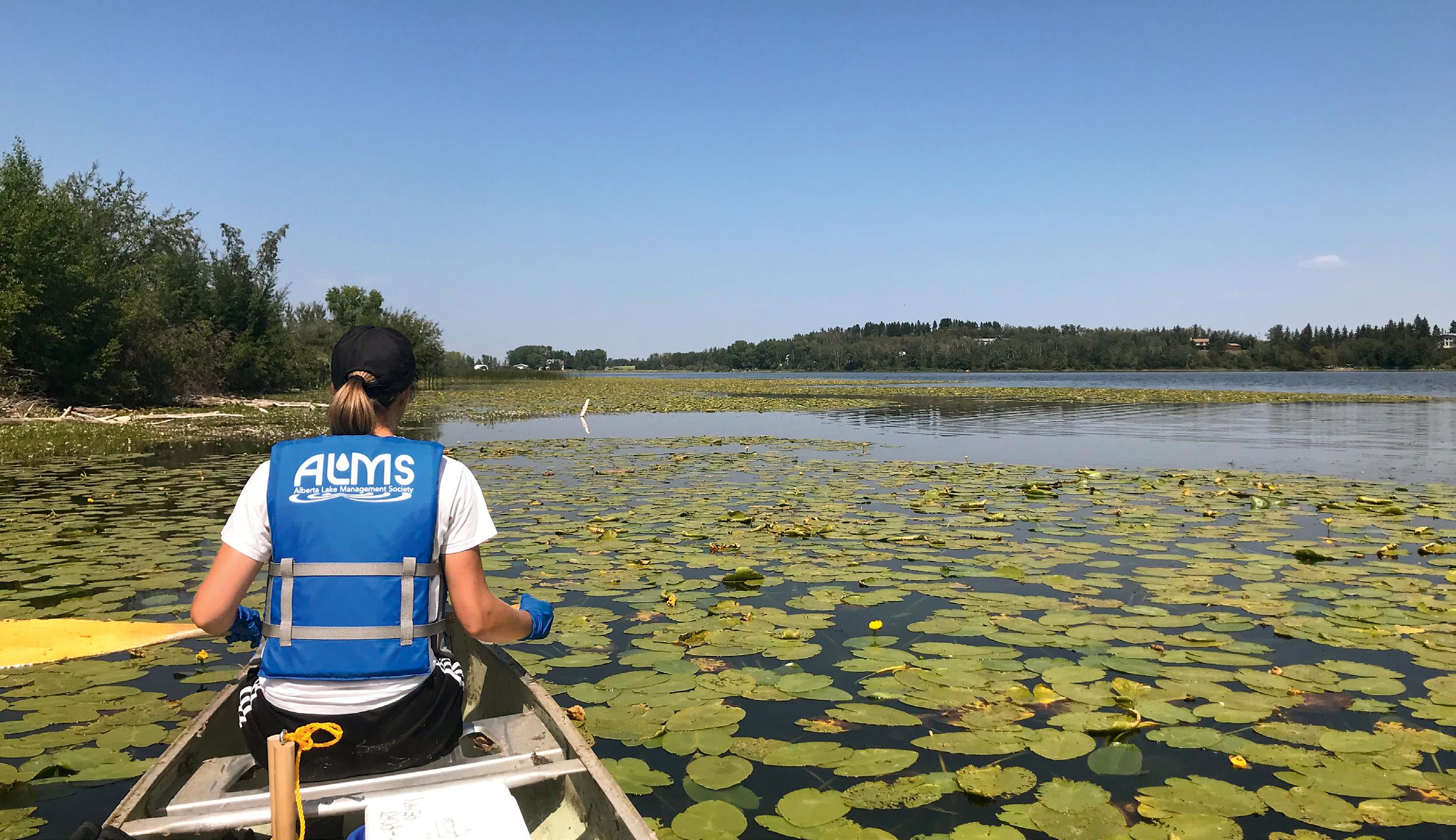
These folks recognize that their lake is a vital resource ... and they work hard to keep it that way.
Monitoring Network. She collects water samples at locations along Truro Creek, which flows southward into the Assiniboine River toward Winnipeg.
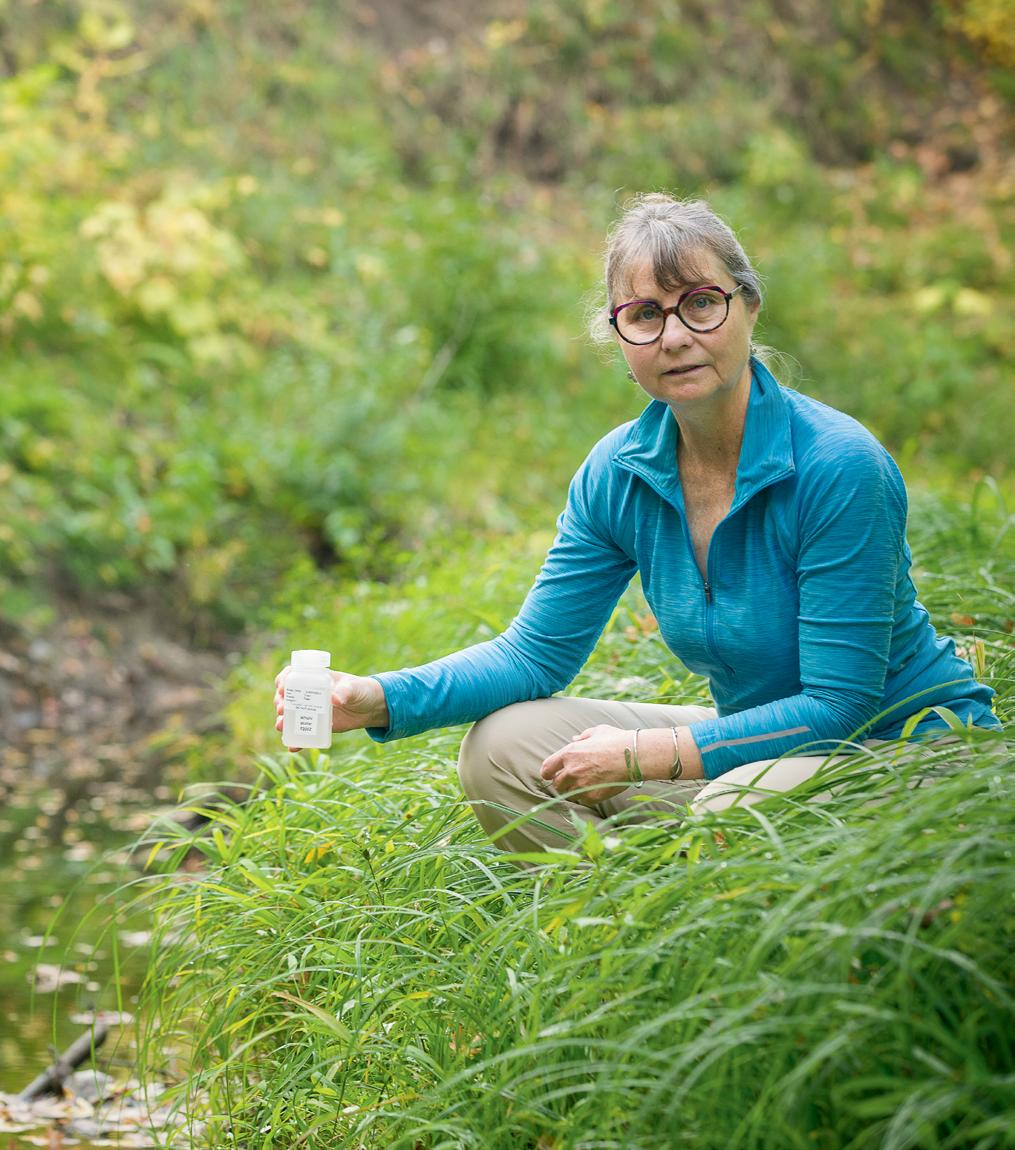
Keast focuses on contributing to a solution, one step at a time. “I love that I am collecting materials that generate data, and that data is going to contribute to identifying phosphorus hot spots, which is going to help target phosphorus-reduction efforts.”
She also loves spending time outside. “There are always hawks, ducks, redwinged blackbirds and, sometimes, foxes.” She’s often approached by people interested in what she’s collecting and why.
If the efforts of stewards like Keast and Abraham are curious to casual interlopers, they’re not lost on officials.
Working with, and learning from, lake stewards is the best part of his job, says Bradley Peter, executive director of the Alberta Lake Management

Society (ALMS), which is responsible for delivering community-based monitoring programs. Peter got involved with the organization as a summer student collecting data. “We leverage the power of the people and the landscape,” he says.
Volunteers working with Peter logged 1,100 hours collecting water-quality data in 2022. This shared information is stored in databases for overarching watershed authorities and governments—a growing repository of information for researchers and policy-makers who use it to make decisions about the country’s natural resources.
The more people help, the more robust—and compelling—the data will be. “Don’t assume someone is already doing it,” says Peter. “It isn’t always the case.” With 20 percent of the world’s freshwater resources in Canada’s care, we’re all responsible for the life-sustaining health of our lakes—one test tube at a time. CAA
Reduce the use of high-phosphorus fertilizers and detergents that can encourage the overgrowth of lake algae and aquatic plants.
Go slow when boating near the shoreline—the wake can cause erosion.
Don’t flush medications or chemicals down the toilet.
Preserve existing shoreline vegetation. It helps fend off erosion, filters water and prevents flooding.
Keep septic systems clean and sealed to prevent pathogens from seeping into groundwater.
✓ First walk-in tub available with a customizable shower
✓ Fixed rainfall shower head is adjustable for your height and pivots to offer a seated shower option






✓ High-quality tub complete with a comprehensive lifetime warranty on the entire tub
✓ Top-of-the-line installation and service, all included at one low, affordable price Now



















Arts and cultural programs are open to all children and youth in Saskatchewan, thanks to the non-profit Creative Kids.
 By Yuki Hayashi |
Tocker
By Yuki Hayashi |
Tocker
DANCE OPENED UP EMILY TANG’S WORLD. She was 10 when she took up ballet and lyrical, and it was the creative release that got her through the challenges of adolescence. “Because of dance, I became more confident,” says Tang. “I no longer felt insecure about the way I looked.”
Participating in artistic and cultural activities provides children and young adults with significant physical, mental and social benefits, according to Shawn Bauche. “For kids facing financial or social barriers and being excluded from certain opportunities, the impact of being given those opportunities can sometimes be life-changing,” says Bauche, a program consultant at Creative Kids, a Regina-based charity that sponsors young people between the ages of 4 and 19 whose families cannot afford to send them to these programs.
Tang, now a science and kinesiology student at the University of Saskatchewan, credits Creative Kids for providing a positive environment that helped her make friends, improve her mental health and inspire her to pursue a career in sports and body movement. “That sense of belonging, the lifelong friendships, [even] just [feeling accepted]…are really, really important,” notes Bauche.
It’s also critical, he adds, that cultural heritage programs cater to local communities, which is why several initiatives focus on Indigenous traditions. According to Statistics Canada’s most recent census, 16.3 percent of Saskatchewan’s population identify as Aboriginal.
Is there an organization in your community that people need to know about? We’d love to hear about it! Get in touch at caa.magazine@caask.ca .
“We have a number of kids taking beading classes, Cree lessons or traditional Indigenous arts. That connection to their roots is essential in [developing] a sense of self, a sense of identity, a sense of belonging.”
Since its launch, in 2010, Creative Kids has funded close to 12,800 applications in more than 251 Saskatchewan communities, reports Bauche. “Some of the early [participants] are now adults, and we’re hearing their stories [on the organization’s] impact on them when they were young and how it has shaped them.”

Creative Kids is funded by provincial grants, corporate sponsorships and private donations. With $5.9 million disbursed over the past 13 years, its top priority is to expand reach within the province, ensuring that as many young people as possible can tap into the programs, or plié or paint or sing their way into the transformative benefits of creative expression.
CAA“
For kids facing financial or social barriers, the impact of being given [cultural] opportunities is lifechanging.Photograph by Danielle On the moves: Program consultant Shawn Bauche (below) has seen, first-hand, Creative Kids’ positive impact on young lives.
AS WITH ANY NEW TECHNOLOGY, people tend to cling to misconceptions based on misinformation and popular myths— until they have the opportunity to experience it for themselves. Electrical vehicles are no exception. Drivers want to know how EVs stack up against traditional internal combustion engine (ICE) vehicles. We’re here to bust, and/or confirm or qualify some of the common perceptions about EVs.

The bottom line: A typical EV will emit, over the course of its life, lower levels of greenhouse gases that impact climate change, compared to an equivalent ICE (gas-powered) vehicle. When considering life-cycle emissions—“cradle to grave” emissions from suppliers, along with manufacturing, logistics, driving and even tual recycling—Volvo found that its gas-powered XC40 emits 58 tonnes of carbon dioxide equivalents (CO2e), while the all-electric XC40 Recharge emits less, at 27–54 tonnes. The large variation comes down to the source of power going into electrical grids.
An EV charged by wind-generated electricity emits 73 percent less CO2e than its ICE counterpart over 200,000 kilometres. There is no data for Canada, but on Europe’s current electrical grid, the EV emits 25 percent less than its ICE counterpart. And, since Canada’s grid is less carbon-intensive on average than Eu rope’s, an EV would be an even cleaner choice here.

Of course, that doesn’t mean you’re doing the planet any favours if you replace a fuel-sipping Toyota Prius hybrid with a Hummer
Yes, the manufacture of EV batteries is a very carbon-intensive process. According to a report by Volvo Cars—which produces EVs and ICE vehicles—total emissions from materials production and refining for its battery-powered SUV is roughly 40 percent more than for its gas-powered equivalent. The battery alone in Volvo’s electric XC40 Recharge SUV is responsible for 10 to 30 percent of its total carbon footprint. New types of EV batteries have the potential to be even far less carbon-intensive, and powering battery production with clean electricity can lower emissions, too. Volkswagen Group’s battery subsidiary, PowerCo, recently chose St. Thomas, Ont., as the site for its first North American cell-manufacturing plant, in part because of the region’s access to clean electricity. The take-away? Yes, for now, manufacturing EVs is dirtier than manufacturing gas-powered (ICE) vehicles. But change is coming.

Today, the vast majority of EV owners charge at home or at their workplace. As EV adoption progresses, however, and more people without access to at-home charging jump on the EV bandwagon, there will be a need for more public chargers— millions more, according to some estimates.
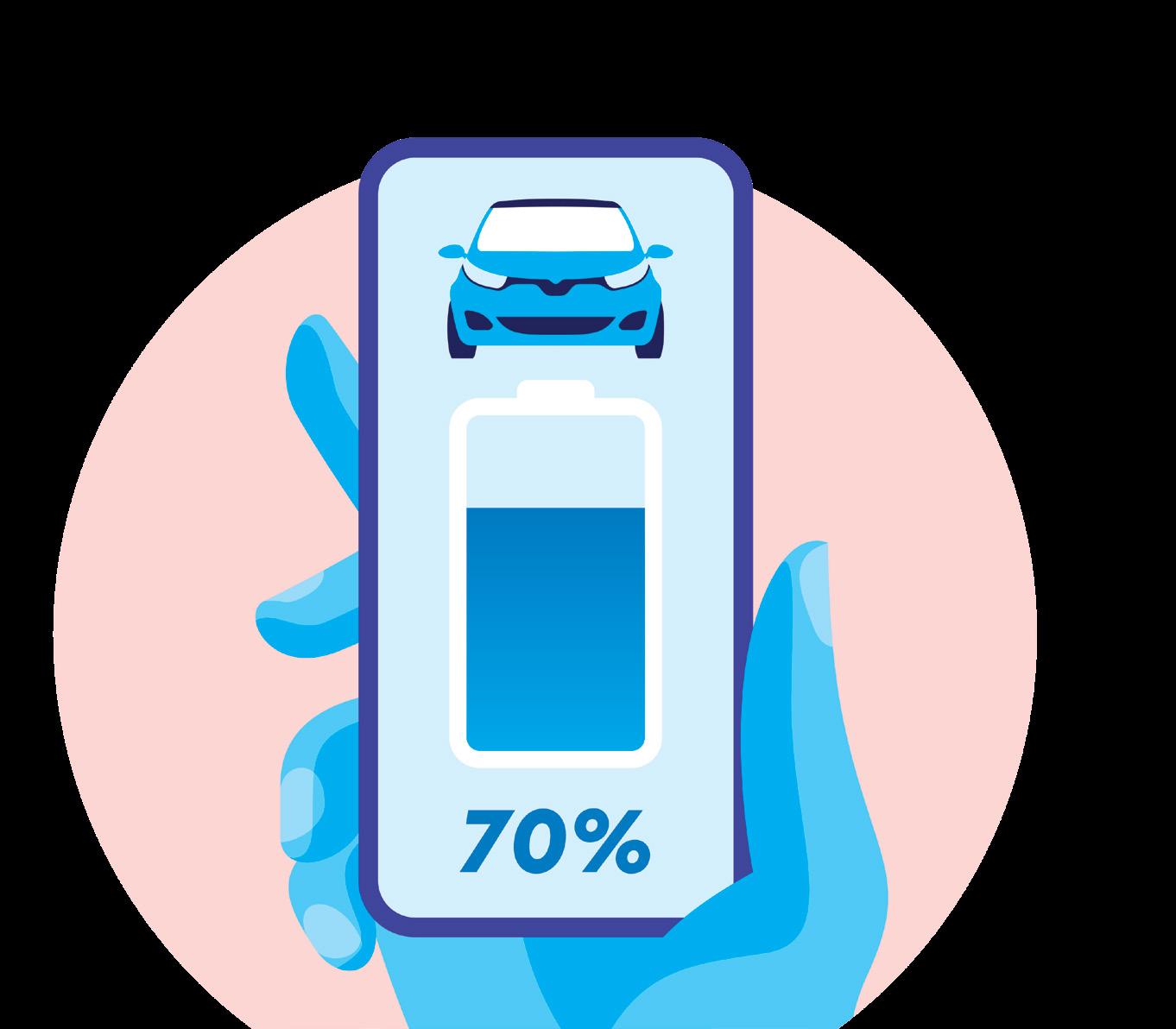
Canada’s public charging network is growing—by almost onethird last year, based on research by Electric Autonomy Canada, a Toronto-based online publication that reports on EVs and autonomous transportation. As of March, there are more than 20,000 charging ports in the country. The big question: Is public charging infrastructure growing fast enough to meet demand?
The European Union recommends one public charger per ten EVs. The Canadian Vehicle Manufacturers’ Association, an auto-industry lobby group, reported that, as of 2020, Canada had 0.06 public chargers per one EV, which is lower than the E.U. average of 0.09. A 2022 study commissioned by Natural Resources Canada found a need for “significant acceleration in charging infrastructure deployment over the next five to ten years.” Tesla is an exception since it has its own nationwide charging network that’s already extensive.

“While commercial charging infrastructure is not where it needs to be, the reality is that 90 percent of most consumer travel happens within small ranges of distance—to work and home, to the grocery store, out on weekends, etc.,” says Colin Fritz, director of automotive services at the Alberta Motor Association. Whether there are enough public chargers for your specific needs
Most of us have experienced the joy of getting a new smartphone—and the anguish of watching its battery degrade until it no longer lasts through the day. EV batteries degrade too, but they’re designed to last much longer—longer even than most buyers keep new vehicles. Check with the manufacturer, but EV batteries should be warrantied for at least eight years or 160,000 kilometres, at which point they must still have at least 70 percent of their original capacity.
Degradation was a serious problem for would-be buyers when EVs had 200 or 250 kilometres of range. Modern EVs now have 400 to 800 kilometres of range, so degrading batteries are less of an issue (at least, for new-EV shoppers; used-EV buyers should evaluate battery age).
“When your battery goes, it doesn’t just fail one day,” notes Ryan Peterson, CAA’s manager of automotive services. “You lose a bit of range, but it’s not like an engine [that] you’ve got to rebuild when it goes.”
EV batteries degrade too, but they’re designed to last much longer—longer even than most buyers keep new vehicles.
Since EV drivers typically recharge their vehicles at home, overnight, recharging is quick. Every morning, you wake up to a fully charged car.

For other, rarer scenarios—a road trip, for example—or for EV drivers without access to at-home charging, public DC fast chargers can juice a vehicle’s battery from near-empty to 80 percent in 30 to 40 minutes. In many cases, you can get enough of a recharge in the time it takes you make a pit stop for a bathroom break and a coffee.

Charging technology is improving, too. For example, the soon-to-be-released Chevrolet Silverado RST pickup is equipped with 350-kilowatt (kW) DC fast-charging. Ten minutes gets you up to 160 kilometres of driving range. The caveat is that there aren’t many ultra-fast 350 kW char-
By Ryan Peterson with Matt BubbersFor my wife and me, this would be our first real road trip in an electric car—a 5,000-kilometre East Coast adventure in our Tesla from our home, north of Toronto, to Quebec, New Brunswick, Prince Edward Island and Nova Scotia.
I won’t lie. Without any experience at all with Tesla’s Supercharger network, I had driving-range anxiety. I didn’t know how charging would work on a long road trip. Before leaving Toronto, I was mapping the whole itinerary, pricing out the charging, figuring out where we are going to stop and for how long. I would need to charge the battery to 100 percent at every stop. Turns out I was wrong.
We bought our Tesla Model Y in May 2022. Then, last August, we decided to take this East Coast trip. On day 1, our destination is Quebec City, 800-plus kilometres away. Our EV officially now has 512 kilometres of driving range.
We get in the car, punch the hotel addresses into the navigation system, and the whole journey is routed for us. Our first charging stop will be in Belleville, for seven minutes, the system tells us. As we are driving along, it notifies us that the charging station is getting pretty busy, so we’re going to charge in Kingston instead. We are automatically rerouted. How cool is that?
We pull up to the chargers in Kingston, which are right off the highway. We time a bathroom break plus some shopping at the convenience store close by. In 12 minutes, we’re ready to go—and so is the Tesla. The battery was recharged to about 60 percent. We hit the road and the navigation system routes us to our next charging stop, about 300 kilometres away, in Montreal.
When we arrive in Quebec City that night, the battery has just 10 percent power remaining. At the hotel, we plug in for free, and by morning, the car is fully charged.
Just take one out for a spin, preferably on a racetrack. The bark of a flat-plane-crank V8 engine and the howl of a high-revving V12 are glorious sounds, but the spooky spaceship whirr of an EV warping towards the horizon never fails to evoke some strong emotions…and audible expressions of wonder.
Learn more at caask.ca/EVs and check out the EV Buyer’s Guide.
After that first day, I realized how stress-free an EV road trip can be. My initial range anxiety was unwarranted. No major detours are required to get to a charging station. And Parks Canada has installed EV chargers, allowing us to power up at Green Gables Heritage Place in P.E.I. and along the Cabot Trail in Nova Scotia.
As well, all through our trip, the hotels we’d booked offer free EV charging, and we also ended up at these wonderful sites we wouldn’t have found otherwise. Driving in a Tesla gives us access to Tesla’s extensive Supercharger network. On the road, we also meet drivers in other EV models who express frustration with the lack of good working chargers. Clearly, there’s a need to improve the EVcharging infrastructure in Canada for drivers of all brands of electric vehicles. Meanwhile, returning home to Toronto, I pull into our driveway, not knowing how much driving range is left on the Tesla. I don’t bother looking at the battery gauge. And to this day, I still don’t.
As I’m driving 5,000 kilometres to Canada’s East Coast and back, my EV anxieties are melting away.







Where nature is unspoiled, the wildlife unfettered, the winter and summer activites are endless.
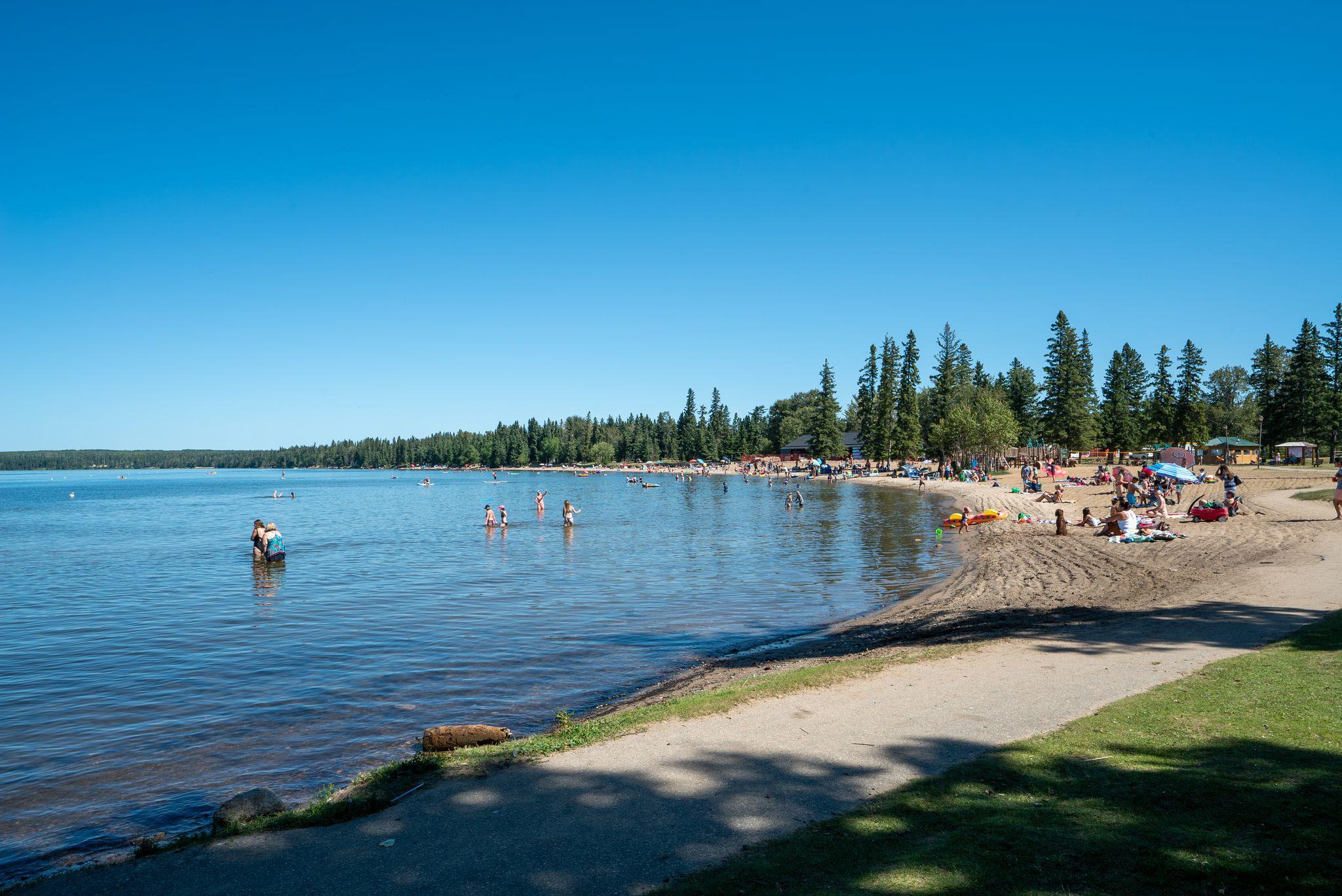




Pack your bags! It’s a great time to visit North Dakota for an unforgettable, affordable holiday. Say hello to the rugged outdoors of Theodore Roosevelt National Park and nearby cities ready to greet you. When getting away is this close, what are you waiting for?

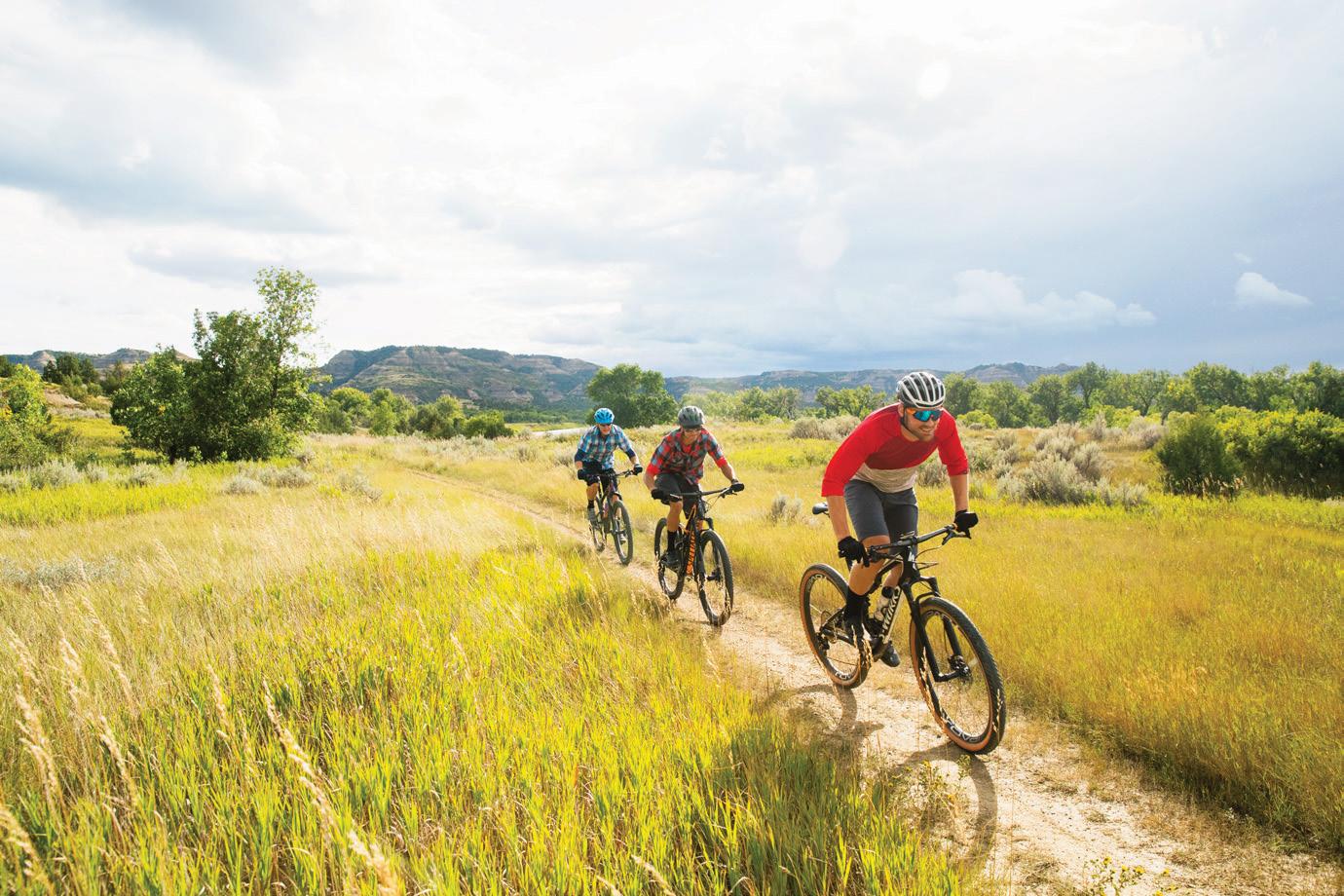
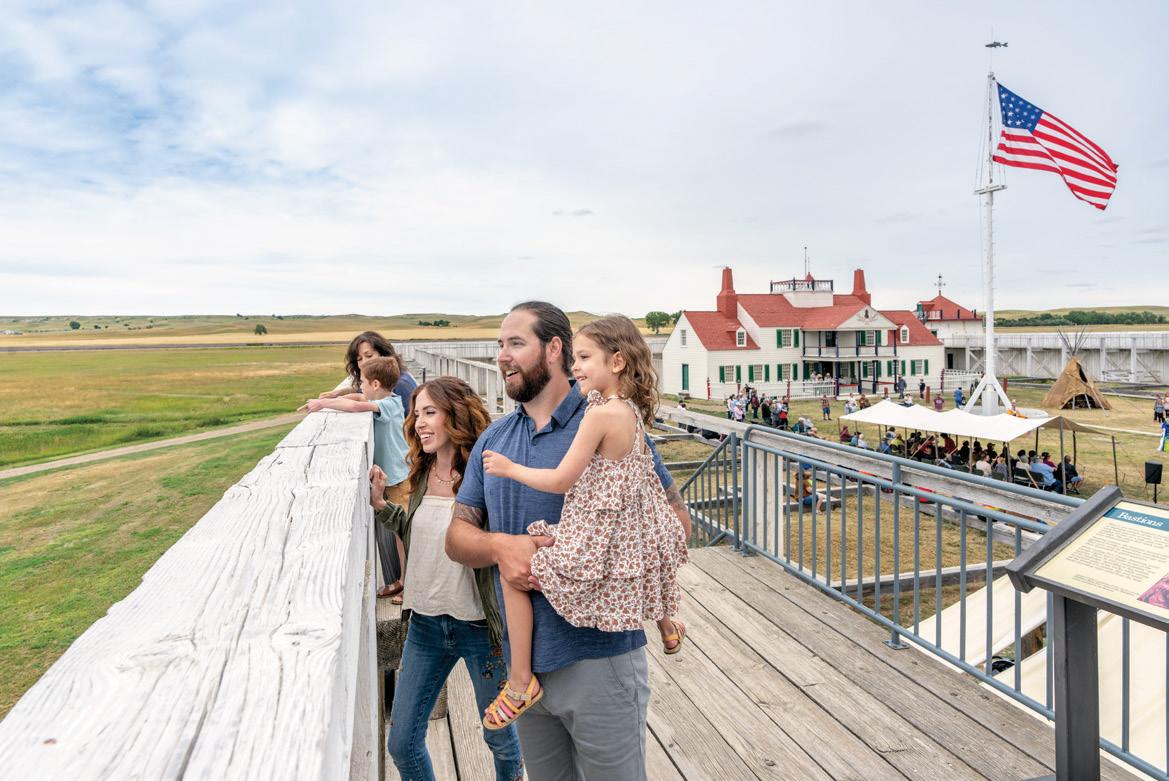
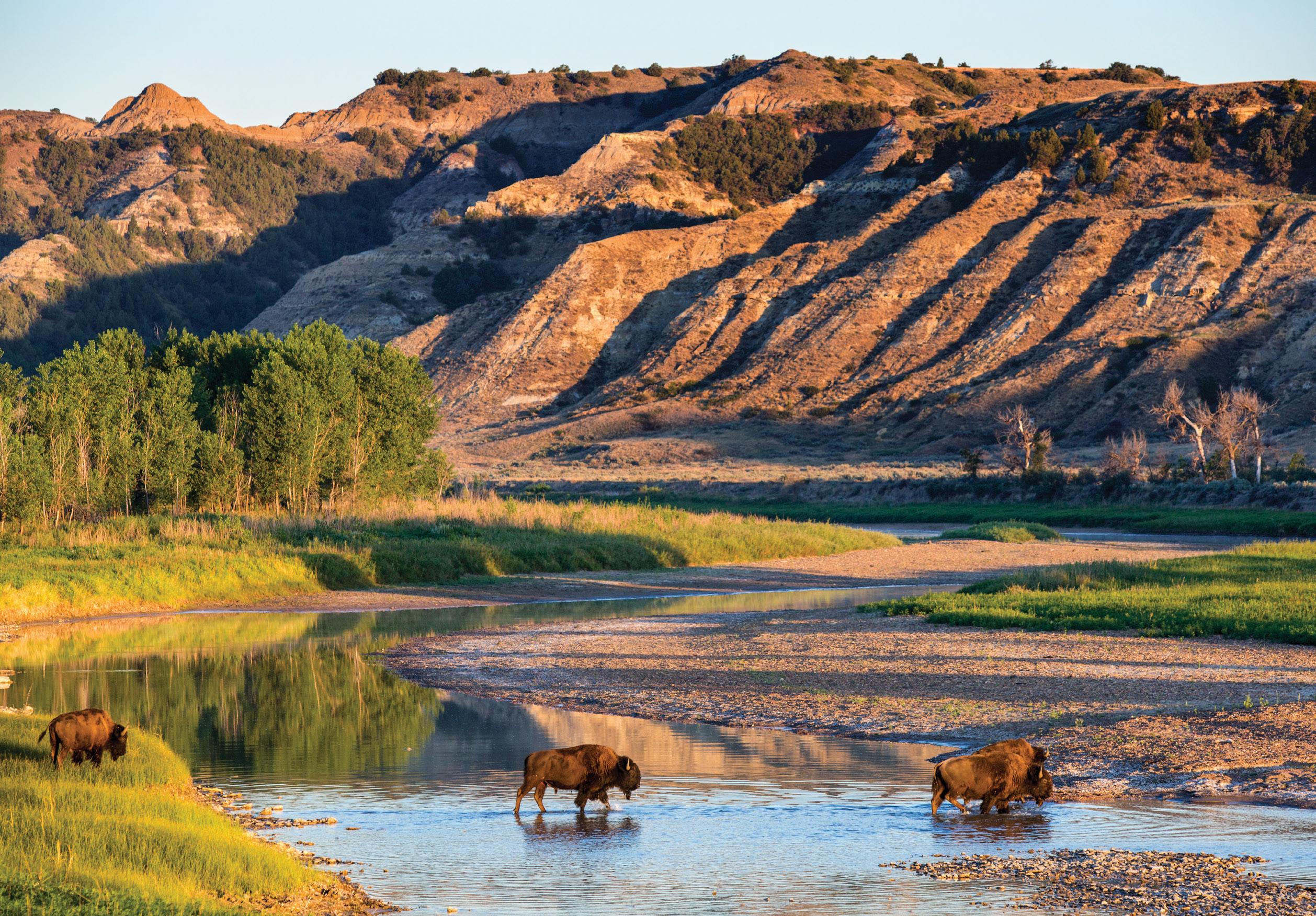

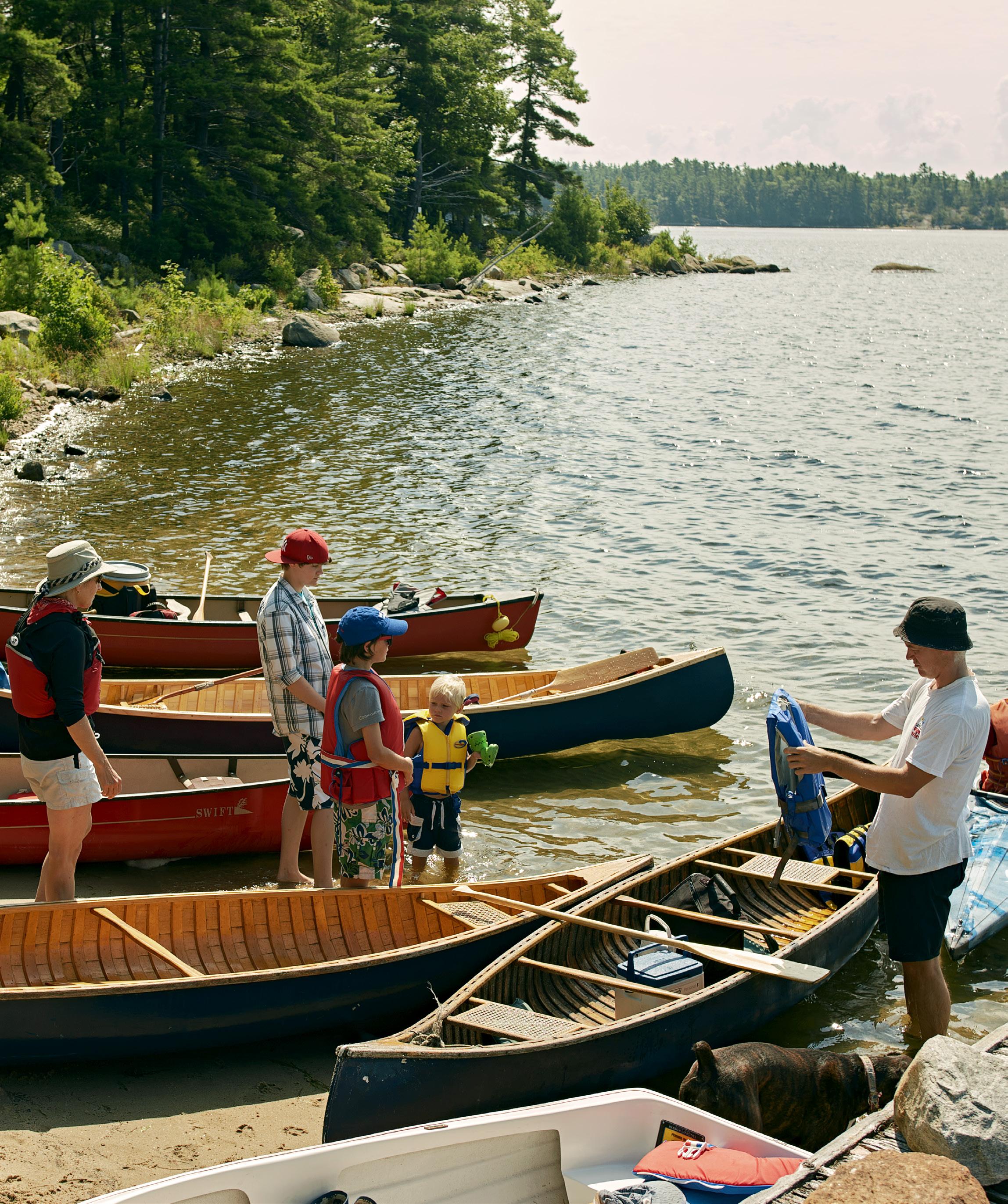
Get set—go on a road-trip adventure.
BEFORE YOU HIT “Start route” on your GPS, consider these tried-and-true road-trip tips for a smooth, enjoyable ride.
• Get organized with a packing list. And when loading up your gear, ensure that the items you need most are at the top for easy accessibility.
• If you’ve planned an overnight stay en route to your destination, pack a small bag with the essentials, so you don’t need to drag in all your luggage for the night.
Backseat diversions
• Fend off that inevitable “Are we there yet?” from the kids by organizing drive-by scavenger hunts, I Spy and Truth or Dare. Other attention-diverting tactics are books and car-friendly games purchased online, say, from Walmart, Puzzle Master and Well.ca via the CAA eStore.
• Listen to a funny audiobook or take turns being the DJ, with everyone allotted a half-hour to play music from their playlists.
• Bring snacks that pack well, aren’t too crumbly and won’t spoil in the summer heat—for example, fruit, beef jerky and bite-sized crackers.
• Elevate your rest stop. Turn it into a roadside dining experience by preparing a picnic. (Bonus points—including savings—for CAA Members who consider CAA dining partners New York Fries and Montana’s.)
• Opt for the scenic route to add fun and interest to your journey. Plan on passing by quirky landmarks and small-town attractions.
Wherever you’re headed, be prepared. Take your CAA membership card with you, or use the CAA app. Make sure your CAA membership is renewed to enjoy your road-trip adventure this summer and the stops along the way.

Ready to hit the gas?
Visit caask.ca for trip planning advice and travel essentials.
Andrew Hiltz—a.k.a. The Saskatchewanderer, Tourism Saskatchewan’s official adventurer—shares three of his favourite spots that are worth the drive.
MEADOW LAKE PROVINCIAL PARK, MEADOW LAKE
Driving across this massive park takes more than two hours. It has 20 lakes and some of the province’s best beaches. Bonus: Trek the Boreal Trail, an epic backpacking route.
DAKOTA DUNES RESORT, WHITECAP DAKOTA FIRST NATION
Home to an award-winning golf course, a newly built resort and casino, farm-to-table dining and traditional Indigenous cultural experiences, booked through Dakota Dunes Adventures.
THE GOLDEN GRAIN BAKERY, MELFORT
Famous for their doughnuts and decadent baked goods, this community hub has been serving up delectable treats for decades.


’Tis the season for treats, picnics and outdoor fun.
TAKE ADVANTAGE OF SUMMERTIME—sunshine galore, warm temperatures—and sweeten time spent with family and friends. Use the perks of your CAA Membership and focus your shopping at CAA Rewards® Partners.


Indulge that sweet tooth with chocolates from Godiva or candy and cookies from Well.ca—and earn 5% in CAA Dollars® on online purchases. Stock up on summer essentials, say, a picnic basket and beach towels from Indigo, and earn 1% in CAA Dollars on online purchases.
Beat the heat with “cooling” items— get a picnic bag with a cooler, or an ice cream scoop and moulds. At Stokes, Members save 5% on the total amount for their online purchases. And don’t forget rainy days. Keep the kids busy indoors with a LEGO set or Puzzle Master games—and earn 3% and 10%, respectively, in CAA Dollars.
Staycationing? Go for a “home sweeter home” with house improvements. You’ll find all the tools and materials you need from CAA Rewards Partners Cub Cadet, Rona and Home Hardware, where Members earn from 2% to 10% in CAA Dollars.



Visit portal.caarewards.ca/caask/ to learn where and how to save with Member-exclusive discounts. Or collect CAA Dollars and shop with CAA Rewards® Partners.

Plan for the best summer ever.
USE YOUR CAA REWARDS® to maximize summertime fun for you and your family. Get exclusive discounts and opportunities to earn CAA Dollars® when you shop, dine out or play this season.
For the latest bicycle parts and accessories, drop by Bruce’s Cycle Works in Saskatoon, where CAA Members can save 10% on all regular-priced items online and in-store.
Explore the great Canadian outdoors with the Parks Canada Discovery Pass for year-round admission to more than 80 national parks and historic sites across the country. CAA Members save up to 10% on Individual Adult or Family/Group passes.
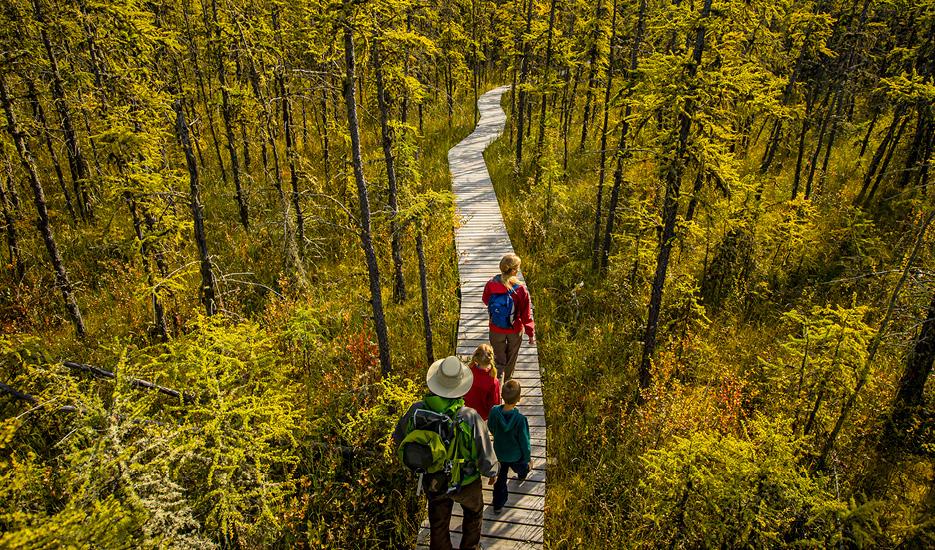



This Transport Canada–accredited card certifies you to get an official boating license. Access the CAA Member-exclusive, limited-time offer from MyBoatCard—use promo code CAAS40 to save 40% on the cost of a Canadian boating license.
Stock up on everything you need to get in the game—sporting goods, sportswear and accessories—at PRFO Sports, where CAA Members
earn 5% in CAA Dollars with online purchases.
Shop at Roots to update your summer outfits and accessories. Use your CAA Membership to earn 10% in CAA Dollars on online purchases of the iconic brand’s handcrafted leather goods, athletic wear and more.
Visit Dakota Dunes Resort, just 20 minutes from downtown Saskatoon. Book a Family Staycation or the Ultimate Family Getaway—and save 15% on the best available room rates when you book online or in-person with your CAA Membership card.
Beat the heat and watch the latest movie in a cool theatre near you. Save up to 30% when you purchase movie-ticket vouchers at any CAA Store.
Plan the perfect summer day. Download the CAA Mobile App™ at caask.ca/ membership/caa-mobile-app and enjoy your savings as a CAA Member.
Keep vehicle costs in check during road-trip season.
Maintenance is key. Summer heat is hard on batteries. Before your trip, have your vehicle’s battery tested and replace it if necessary. And keep in mind that fuel consumption can increase by 4 percent if your tires are under-inflated.
Get your car serviced. Before you head out, bring your car in for CAA’s 139-point Vehicle Inspection Service at any CAA-Approved Auto Repair Services facility or at Regina’s CAA Car Care Centre at Regina Battery Depot..
Maximize fuel efficiency. There are simple things you can do to reduce fuel consumption. Remove roof racks to reduce drag. Accelerate and decelerate gently to reduce wear and tear.
Visit caask.ca/consumer-education for tips on making a tank of gas last longer and lowering vehicle maintenance costs.
Almost time to renew your CAA Membership? Keep enjoying the peace of mind and benefits that come with being a CAA Member. Sign up for automatic renewal today at caask.ca/MyAccount or call us at 1-800-564-6222 (option 2).
We each have a part to play in keeping each other safe.
DRIVING IN THE SUMMER is more than just a two-way street—roads are busy with pedestrians, motorcycles, scooters, bikes and e-bikes. And there’s usually a lot of construction thrown into the mix, along with detours and traffic delays, as well as driver distractions. Everyone has to work together to ensure we all arrive at our destinations safe and sound.
“Road safety depends on the cooperation of all road users,” says Christine Niemczyk with CAA Saskatchewan.
Most motorists are or have been cyclists, and most adult cyclists also drive motor vehicles, according to Statistics Canada in a recent report. The research also stated that, on average, 74 Canadians die in cycling collisions each year and 73 percent of







• Leave at least one metre of space between you and cyclists.
• Check your mirrors and blind spots before turning, changing lanes, passing, or merging.


• When parked on the street, don’t open your door into traffic. Instead, do the Dutch Reach and check your blind spot first.


those incidents involve a collision with a motor vehicle.
Distraction plays a role in many collisions. “All road users—regardless [whether or not] you are a pedestrian, a cyclist or on a scooter, or a driver—should always have their full attention on the road,” says Niemczyk. “Avoid distractions like cellphones when in motion.”
Everyone on the road should be aware of their surroundings and have a safety-first mindset. This includes scanning ahead, exercising caution and assuming that you may not be seen or heard by other road users.


Niemczyk recommends these tips for anyone on the road this summer, no matter your mode of transport:

• Ride single-file on the road. Avoid cycling on the sidewalk.
• Use a bell and hand signals to communicate with other road users.
• Come to a complete stop at intersections.
• Use crosswalks and controlled intersections where possible.
• Put away your cellphone and headphones when crossing a street.
Visit


Make Shell your road-trip partner.
CLEAR SKIES AND WARM WEATHER are the only excuse you need to turn on some tunes and hit the road this summer. Make your road-trip even better by loading your CAA Membership in the Shell app. Receive exclusive benefits when using the app. Use the station locator tool on the app to find participating Shell stations along your route, then head out.
Fuel up Save 3 cents per litre on any grade of fuel. Swipe your CAA Membership Card when you pay at the pump—or leave your card in your wallet and pay easily in the Shell app.
Chow down Save 10% on road-trip snacks and drinks to go. Your vehicle isn’t the only thing that needs to fill up.
Freshen up
CAA Members are also eligible for 10% off car washes. Add a basic, deluxe or ultimate wash at the pump, then present your CAA Membership Card when you pay in-store. Or simply pay in the Shell app from the comfort of your car.
The Shell app is fast, easy, and the most convenient way to save instantly. Download the Shell app and load your CAA Membership today.


SASKATCHEWAN’S GOLF SCENE offers plenty of choice to challenge and delight any golfer. Here are 10 courses worth the drive—and the driver.
SOUTH
TS&M Woodlawn Golf Club
Estevan
• Undulating greens, carved fairways and plenty of natural hazards.
Maple Creek Golf Club
Maple Creek
• Panoramic views of scenic Cypress Hills from every hole.
Elmwood Golf & Country Club
Swift Current
• A rare layout that challenges seasoned players while appealing to newcomers.
CENTRAL The Legends Golf Club
Warman
• A premium golf destination that plays host to provincial championships.
Echo Ridge Golf Course
Fort Qu’Appelle
• A challenging 9-hole course, friendly staff and laid-back atmosphere.
Crystal Lake Golf & Country Club
Crystal Lake
• Wide fairways, mature trees and strategically placed sand traps.
Harbor Golf Club & Resort
Elbow
• An 18-hole course on the bluffs overlooking Lake Diefenbaker.
NORTH
Evergreen Golf Course
Nipawin
• A Les Furber–designed course, nestled amid jack pines.
Meadow Lake Golf Club
Meadow Lake
• The back nine is well-treed, while the front nine has water, sand and rolling hills.
Hidden Hills of Shellbrook Golf Course
Shellbrook
• Manicured fairways, rolling greens and at least three tee boxes on every hole.
Members save up to 30% on an online purchase of the Canada Golf Card using promo code CAASK23, which entitles them to discounts and promotions at more than 700 golf courses across North America. Visit info.caask.ca/canada-golf-card for details.

CAA Insurance protects recreational properties and vehicles.

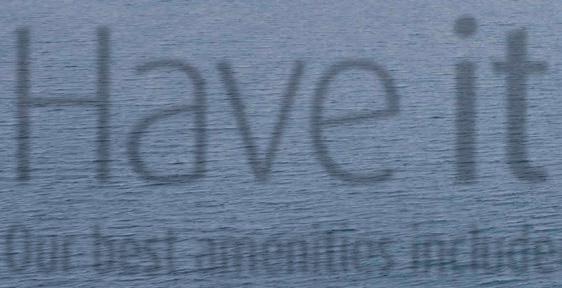























THE COTTAGE IS DE-WINTERIZED, the boat is back in the water and the RV is ready to hit the road. Now is the time to make sure your insurance covers them all.


“Treat your seasonal properties and toys the same as [you would] your home,” says Lori Madsen, general manager of CAA Saskatchewan Insurance Services. “[Your recreational property] is your home away from home.”
Check the insurance coverage on your vacation property, as well as any outbuildings, RVs, trailers, ATVs and boats. Be sure to read the policy to know what’s covered and what may be limited or excluded. “Most policies have limits on your toys, watercraft, bicycles and trailers,” notes Madsen. “And some policies don’t extend any coverage to RVs, ATVs or other motorized vehicles.”





While it’s important to make sure these items are covered in the event of theft or damage, make sure too that you’re covered for liability losses.
“CAA has knowledgeable, professional and helpful staff who have been trained to assist you in finding the right coverage,” says Madsen, “so you can enjoy the summer knowing you are fully protected.”























PACK YOUR BAGS! Update your luggage and travel accessories. CAA Stores has top-notch brands to complement your summer outings this year.
Pacsafe Metrosafe LS350 15L Backpack

Member: $112.
Non-member: $124.95
Store everything you’ll need for the day in this compact anti-theft bag. Features include a TurnNLock security hook, lockable zippers and cut-resistant straps.
Go Travel Worldwide USB Charger
Member: $31.49. Non-member: $34.99 Travelling outside of Canada? Don’t leave home without this charger, which can power up four USB devices at the same time and has interchangeable U.S., U.K., E.U. and Australasian plugs.

Pacsafe Coversafe S100 Secret Travel Waist Pouch

Member: $23.70. Non-member: $24.75
Keep your valuables safe—and close, literally— while travelling. Stash your passport, travel documents, credit cards and cash in this nylon spandex pouch underneath your clothing.
Travelon Inflatable Bottle Pouch

Member: $16.
Non-member: $18
Designed to safely transport the contents of a standard-size bottle of wine or spirits, this leak-proof pouch meets airline requirements for checked luggage.
Travelon 4 In 1 Car Tool
Member: $22.50. Non-member: $25
Be emergency-ready on the road. This multi-function device can cut through seatbelts and break windows, if necessary, and indicate your location via its flashing red-light beacon.
Find these savvy traveller’s companions and more at caask.ca/shop Or browse our stores in Regina, Saskatoon, North Battleford, Prince Albert, Yorkton, Moose Jaw, Swift Current, Estevan and Weyburn.
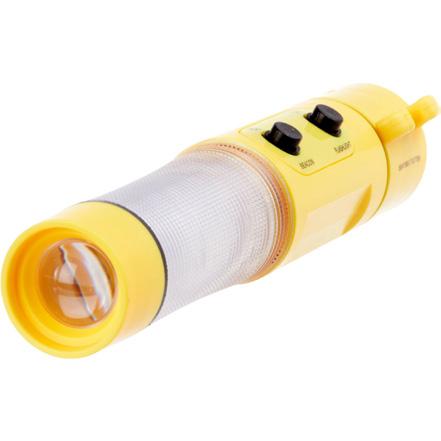
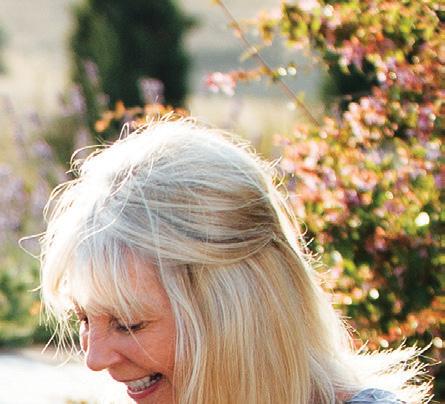
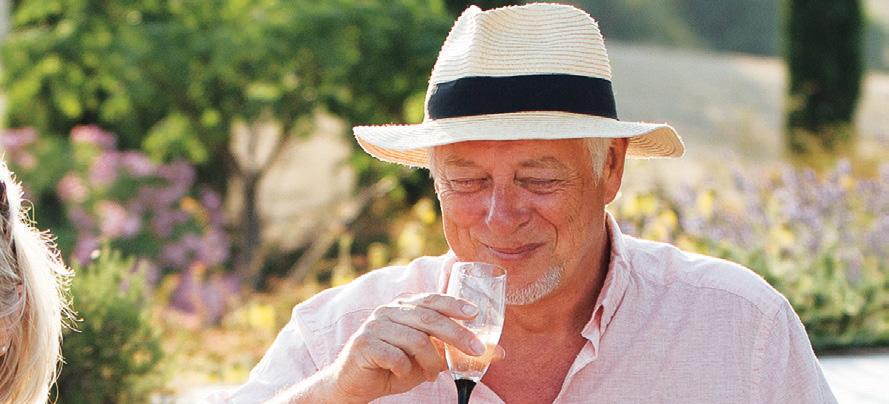
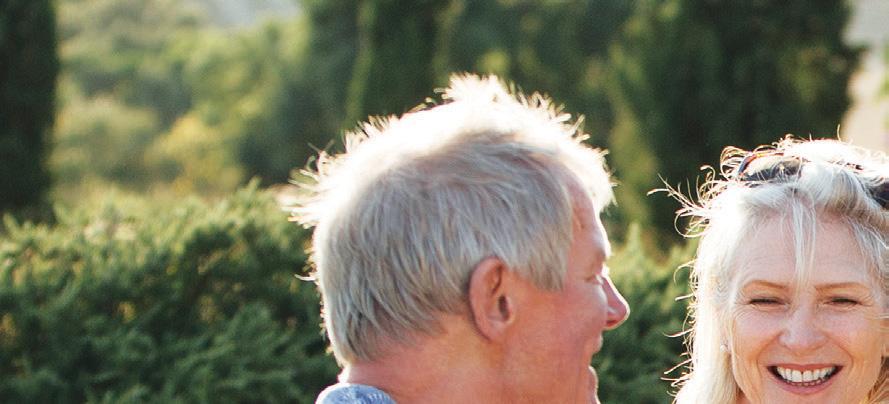





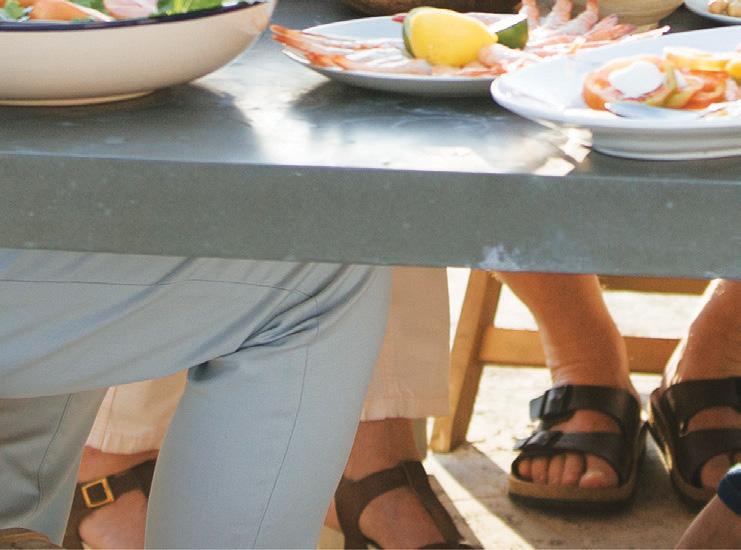




Looking for adventure, food, or solo travel with customized itineraries? Or maybe you prefer sharing experiences with like-minded individuals on group travel and sports tours? Delve into faith and culture with religious tours, all while enjoying CAA Travel’s trusted service for a safe and enjoyable journey. Don’t wait, book now and create unforgettable memories!
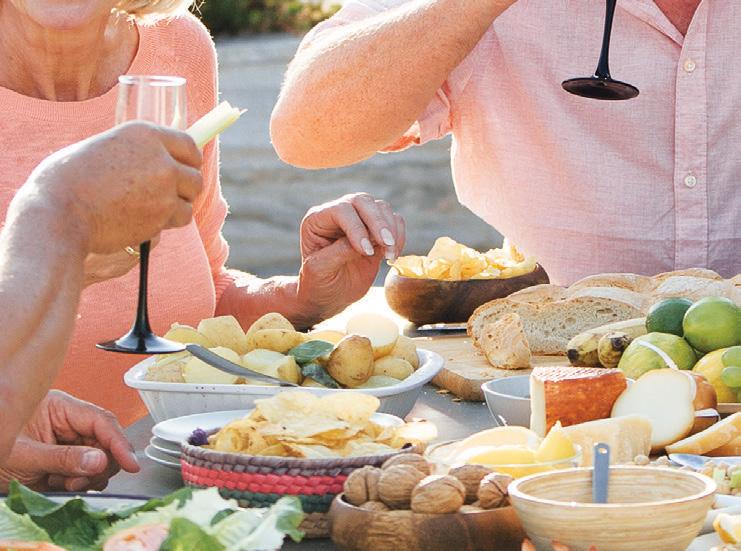
TRAVELLERS WITH WESTWORLD TOURS and Women Xplorers have the world at their feet, (or should we say their seat) – without the hassle of planning. If you have never travelled on a WestWorld Tours escorted group, then you are in for a treat!

WestWorld Tour Directors often hear guests comment on how it really is a worry-free trip. How wonderful it is to sit back, look out the window and enjoy the scenery instead of worrying about the roads and routes, the planning and parking, and the added costs of travelling independently, not to mention traversing the traffic!
WestWorld Tours understands travelling can be stressful and strives to present a worry- and stress-free vacation. Professional Tour Directors play a significant role in the experience, guests receive personalized service from start to finish. Tour directors personally contact each guest prior to departure to introduce themselves and answer any questions. While on tour, they take care of all the details so guests can enjoy the experience. With premium accommodations in prime locations, deluxe transportation with experienced drivers that take you to all those exciting places and attractions!
The most commonly mentioned concern from newbie travellers with WestWorld Tours, turns out to not be a concern after all! Some are apprehensive about long travel days aboard the coach, and surprisingly (not surprising to WestWorld Tours), time and time again, at the conclusion of the tour, feedback from guests will say, they were impressed at how fast the time goes and how much fun it is on the bus.
Most frequently guests share that they receive excellent value for their dollar, and about the new friends and memories they’ve made along the way!
Contact a CAA Travel Consultant about exploring the world with WestWorld Tours. caask.ca/travel or call 1-800-564-6222

Experience the best of Newfoundland, Labrador and the Maritimes with WestWorld Tours, including puffin and whale watching, visiting an 11th century Viking settlement and exploring Anne of Green Gables farmhouse.
Enjoy these tours on their own or combine them to discover the compelling beauty of Atlantic Canada, where locals welcome you with open arms and a culture so rich you can’t help but be inspired as you enjoy breathtaking vistas along the way!

Ireland & Scotland | August 20 - September 6, 2023

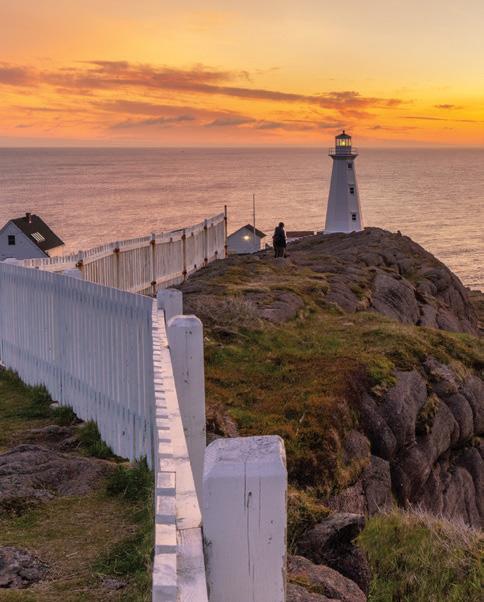




Got car questions? We’ve got answers.
CAR EXPERT DOUG BERNER, service manager at the CAA Car Care Centre in Regina, answers questions from our readers.
Premium tires are exactly that—premium tires that you expect to perform and last as advertised. The saying “You get what you pay for” was certainly true at one time, as there was a noticeable difference in performance and durability between premium and economy tires. That gap has narrowed in the last few years, with some economy brands exceeding expectations.
A consumer should be informed as to what they’re buying and anticipate the expenses incurred with owning a hybrid. On average, a hybrid battery will last about eight to ten years, or around 160,000 kilometres. The cost to replace a battery can range from $4,000 to $8,000 or more, which translates into a substantial expense that you would unlikely see with a conventionally powered vehicle with the same age and mileage. Be aware of what you are getting into before buying.
CAA SASKATCHEWAN IS PROUD to support our communities at these events:
Jim Pattison Children’s Hospital Foundation Jeans & Jewels Gala
Supporters of the foundation’s maternal and children’s programs gathered in Saskatoon for a reception and auction, and got their boots scootin’ to the music of country star Aaron Pritchett. CAA Saskatchewan was thrilled to support this May 5th event as the Champion Child Sponsor, with ambassadors from the CAA Saskatoon Store.
Access Communications Labour Day Show N Shine
Annually on Labour Day Monday, Access Communications hosts this event along with Collector’s Car Club, that showcases hundreds of antique, classic and vintage vehicles and motorcycles (and their owners) to raise funds for the Regina Food Bank. CAA is back this year as a presenting sponsor. Come out and vote for your favourites.
Before you drive, reduce distracted driving by adjusting your seat, mirrors and other vehicle settings. Keep your eyes and mind on the road.

Buckle up. Ensure seat belts are used by all occupants. Children must be properly secured in car or booster seats.
Drive according to weather and road conditions.
Slow to 60 km/h on Saskatchewan highways for working tow truck operators and first responders. It’s the law.
Remember CAA Roadside Assistance is available, 24/7, 365 days a year.
We’re sharing stories about Canadians creating change that ripples from coast to coast. For this inspiring teacher, going above and beyond means following his students.
By Sean Deasy |STEVE SCHULTZ knows how to cultivate some genuinely good ideas.
Schultz, who’s a CAA Member, is a science teacher at Lacombe Composite High School in the city of Lacombe, in central Alberta. Under his guidance, his students have brought eco-friendly projects to life both at their school and in their community.
It all started in 2006 with a three-year initiative that led to the installation of 32 solar panels at the school. Since then, the students have achieved a lot—from planting a food forest of 200 fruit trees to converting a portable classroom into a near-net-zero greenhouse. Their efforts have not gone unnoticed.
In 2022, Lacombe Composite was the only North American school to be shortlisted in the global organization T4 Education’s competition, World’s Best School Prize for Environmental Action.
Schultz—a recipient of the Prime Minister’s Awards for Teaching Excellence in science, technology, engineering, and mathematics (STEM)—has also created online resources, so other teachers can replicate projects. One of his passions is to elevate agriculture education in Canada, the only G7 country that doesn’t emphasize the curriculum.
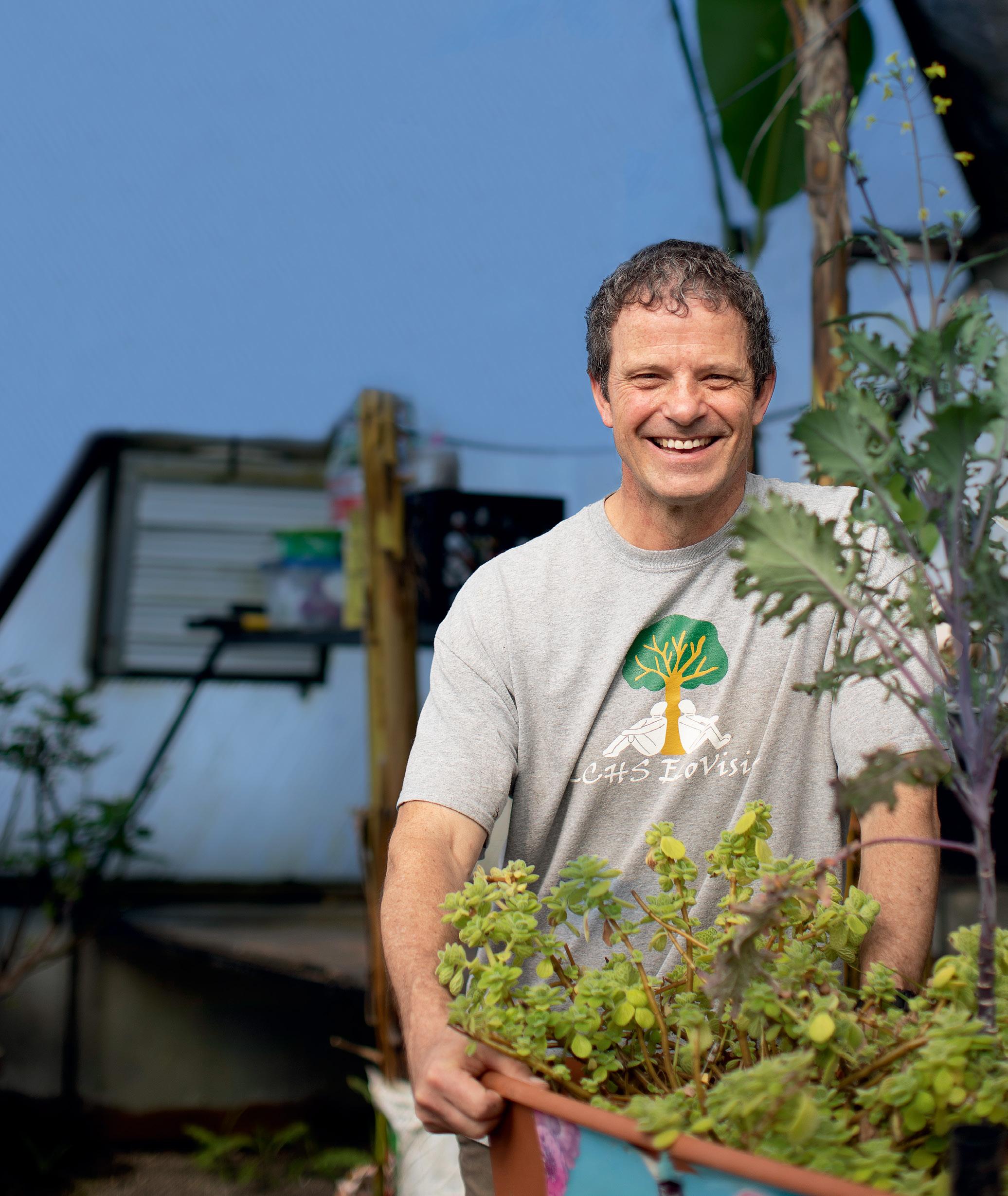
“Agriculture needs to be in more schools,” he says. “It’s become my secondary passion to spread that message to as many people as I can and model what it could look like.” CAA
Canadians doing
their
It’s a different world up here. Learn why.


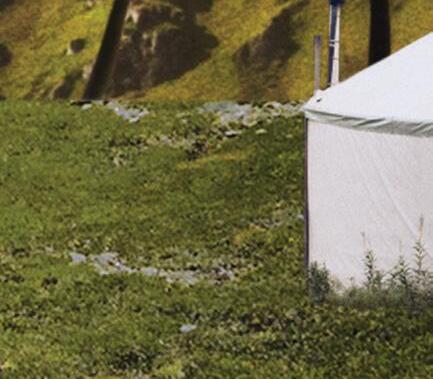














With the midnight sun, you’ll have more diem to carpe.
